

A recent survey conducted by the North American Van Lines relocation company found that more than 70% of American adults live in or near the city where they grew up. But for those who make a deliberate choice to move away from home, the decision is often influenced by one or two key factors.
Some may choose to move to a new city to find a better job. A family may buy a home in a new neighborhood to enroll the children in a better school district. Retirees may relocate to be in a warmer, sunnier climate, while others may choose a new place to live in an area with lower crime rates or more affordable housing. The list of reasons varies. (Here are America’s least dangerous states.)
Indeed, key economic, social, and environmental factors can all be important considerations to make when deciding on a place to live – and these factors can change significantly from state to state.
Using data from sources including the U.S. Census Bureau, the FBI, the Environmental Protection Agency, and the Bureau of Labor Statistics, 24/7 Wall St. created a weighted index of 16 measures to determine the best – and worst – states to live in.
Each measure used in our index has an impact on overall quality of life. These measures include those related to the economy such as unemployment and poverty; the environment such as air pollution; and social factors such as crime and levels of investment in public works and institutions.
There are some notable geographic patterns in the ranking. For example, eight of the 10 lowest-ranking states are in the South, while the highest ranking states are concentrated in the West and the Northeast. (Here are 22 states where people live the longest.)
It is important to note that each state, regardless of its ranking, has some positive attributes as well as some negatives. For example, while many of the Southern states rank lower on this list, often due to higher crime and poverty rates, many may also make an ideal home due to warm climates, a low cost of living, and affordable housing.
Click here to see the best and worst states to live in 2022.
Click here to see our detailed methodology.
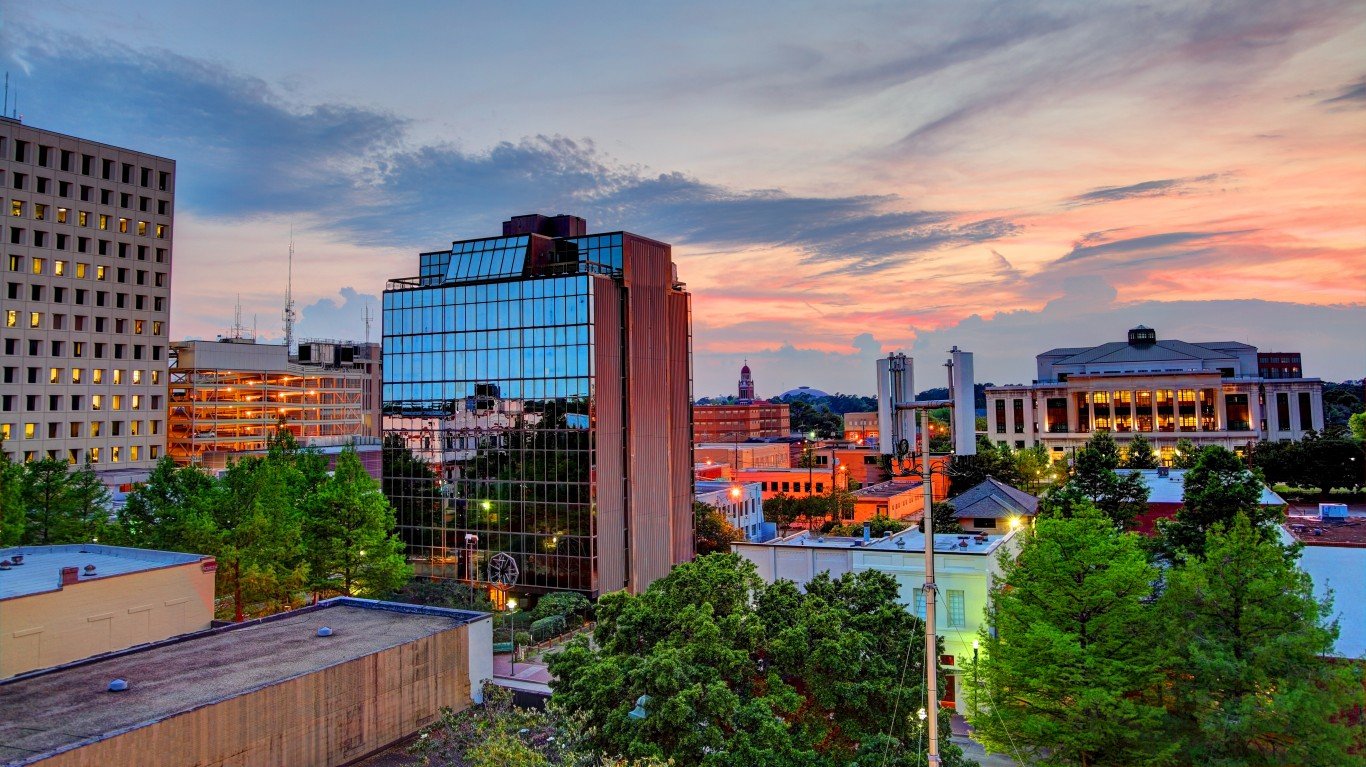
50. Louisiana
> Population: 4,624,047 (-0.7% in last year)
> Life expectancy at birth: 75.2 years (5th lowest)
> Median household income: $52,087 (3rd lowest)
> Median home value: $192,800 (11th lowest)
> Median housing costs as pct. of income: 15.5% (9th lowest)
> August 2022 unemployment: 3.8% (19th highest)
Based on a range of key socioeconomic indicators, Louisiana ranks as the worst state in the country to live in. While the state has advantages, including a low cost of living and more sunlight than most of the country, it compares less favorably in other ways.
For example, Louisiana’s 2020 violent crime rate of 640 reported incidents per 100,000 people is fifth highest among states. Incomes are also generally low in the state, with most households earning only about $52,000 or less annually, while most households nationwide earn over $69,000 annually. Women in the state’s workforce are especially disadvantaged, earning only about 73% as much as their male counterparts, the second worst gender pay gap among states. Additionally, about one-in-every-five Louisiana residents live below the poverty line, the largest share of any state.
[in-text-ad]
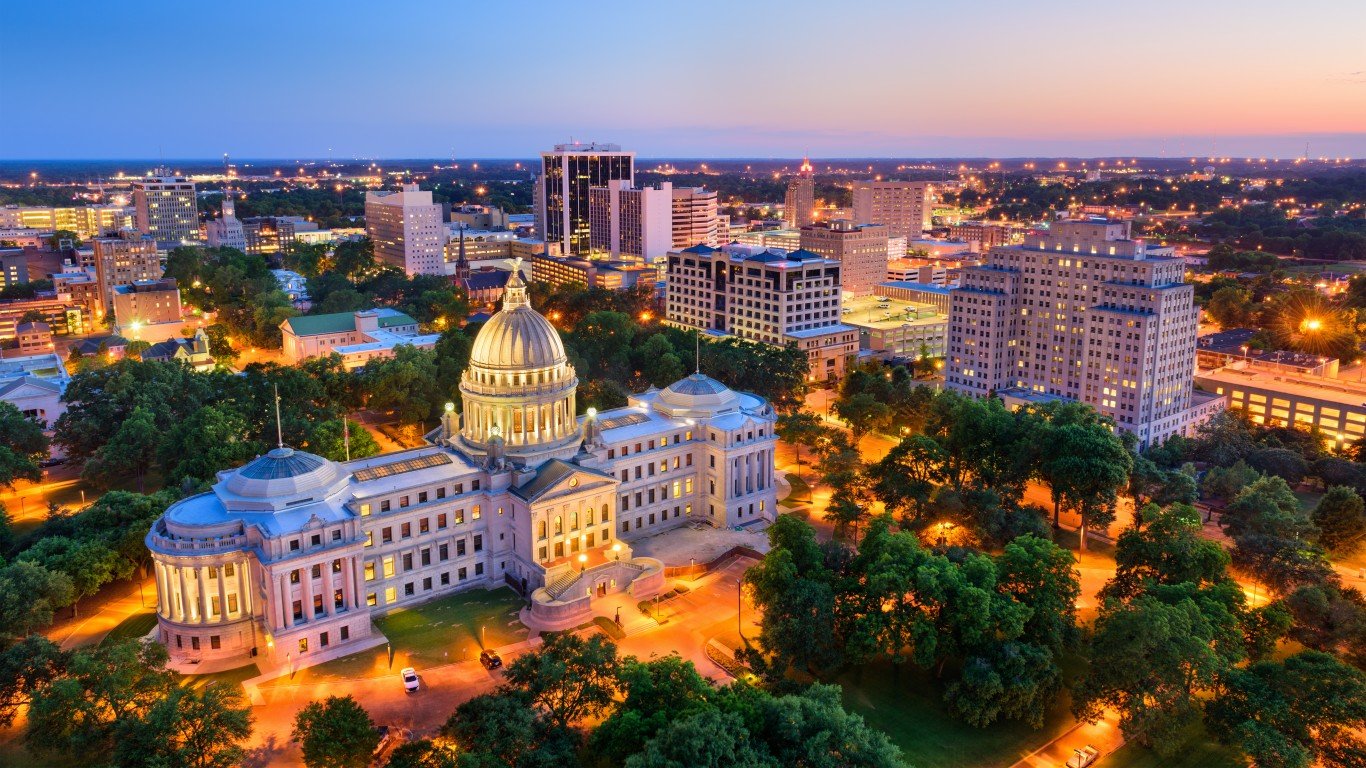
49. Mississippi
> Population: 2,949,965 (-0.4% in last year)
> Life expectancy at birth: 73.9 years (the lowest)
> Median household income: $48,716 (the lowest)
> Median home value: $145,600 (2nd lowest)
> Median housing costs as pct. of income: 15.1% (5th lowest)
> August 2022 unemployment: 3.8% (19th highest)
Like neighboring Louisiana, Mississippi ranks as one of the worst states to live in. At just 73.9 years, average life expectancy at birth in Mississippi is the lowest of any state, suggesting many state residents have inadequate access to health care. Indeed, the state has one of the lowest health insurance coverage rates in the country.
Lower-income Americans are less likely to be able to afford health care or healthy lifestyles and diets, and the typical household in Mississippi earns just $48,716 a year, the least of any state. Other economic indicators are also lagging in the state. The most recent monthly jobless rate in the state of 3.8% is higher than in most states and Mississippi is also struggling to build its college-educated labor force, attracting relatively few college-educated new residents. Only 0.7% of all adults in the state who have a bachelor’s degree moved there in 2021 – one of the smallest such shares in the country.
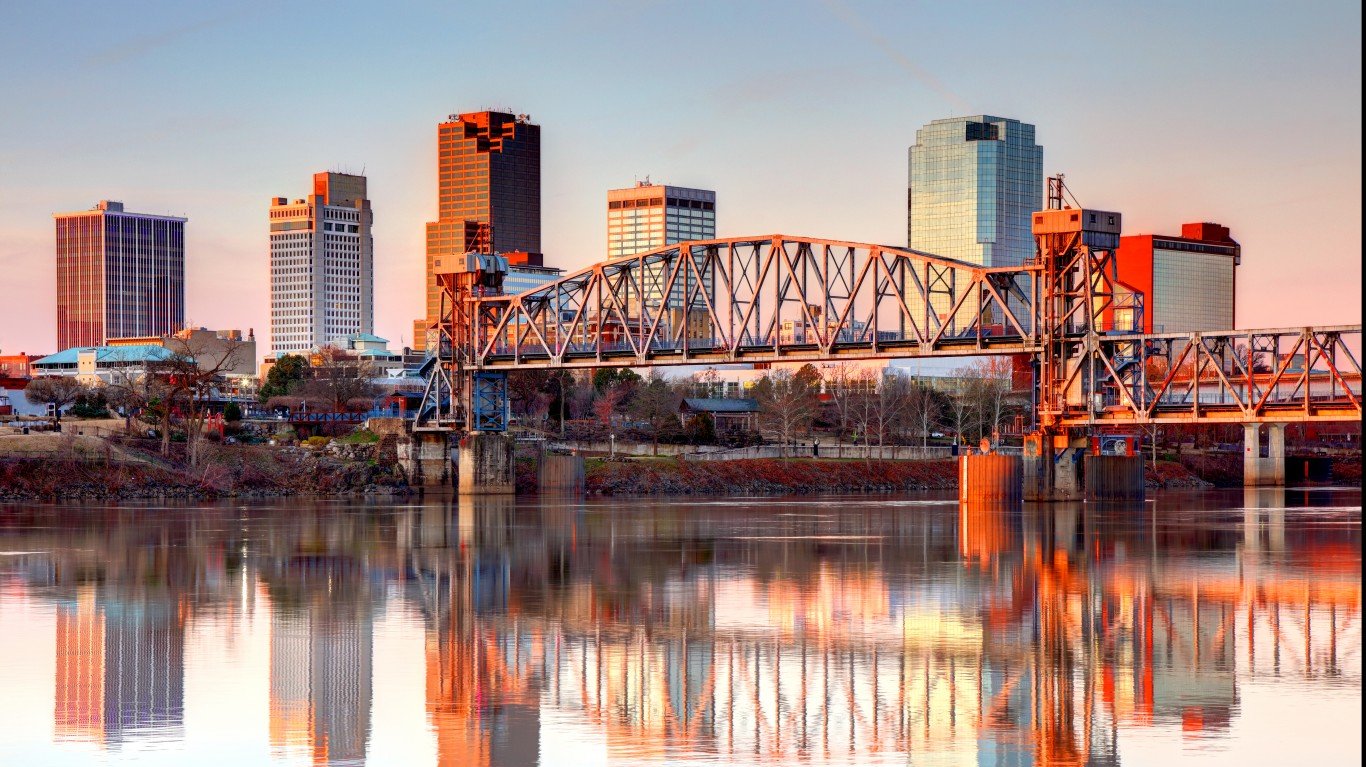
48. Arkansas
> Population: 3,025,891 (+0.5% in last year)
> Life expectancy at birth: 75.5 years (7th lowest)
> Median household income: $52,528 (4th lowest)
> Median home value: $162,300 (3rd lowest)
> Median housing costs as pct. of income: 14.7% (2nd lowest)
> August 2022 unemployment: 3.5% (24th highest)
Arkansas ranks as the third worst state to live in, partially because of widespread financial hardship. The typical household in the state earns just $52,528 a year, and 16.3% of the total population live below the poverty line. Meanwhile, nationwide, the median household income stands at $69,717 and the poverty rate is 12.8%.
Access to public amenities like parks and recreation centers is also limited in Arkansas. Only about 56% of the population have easy access to places for physical activity, well below the 80% share of Americans nationwide who do. Financial hardship and limited access to places for exercise likely contribute to the state’s low average life expectancy at birth, which, at 75.5 years, is seventh lowest of all states.
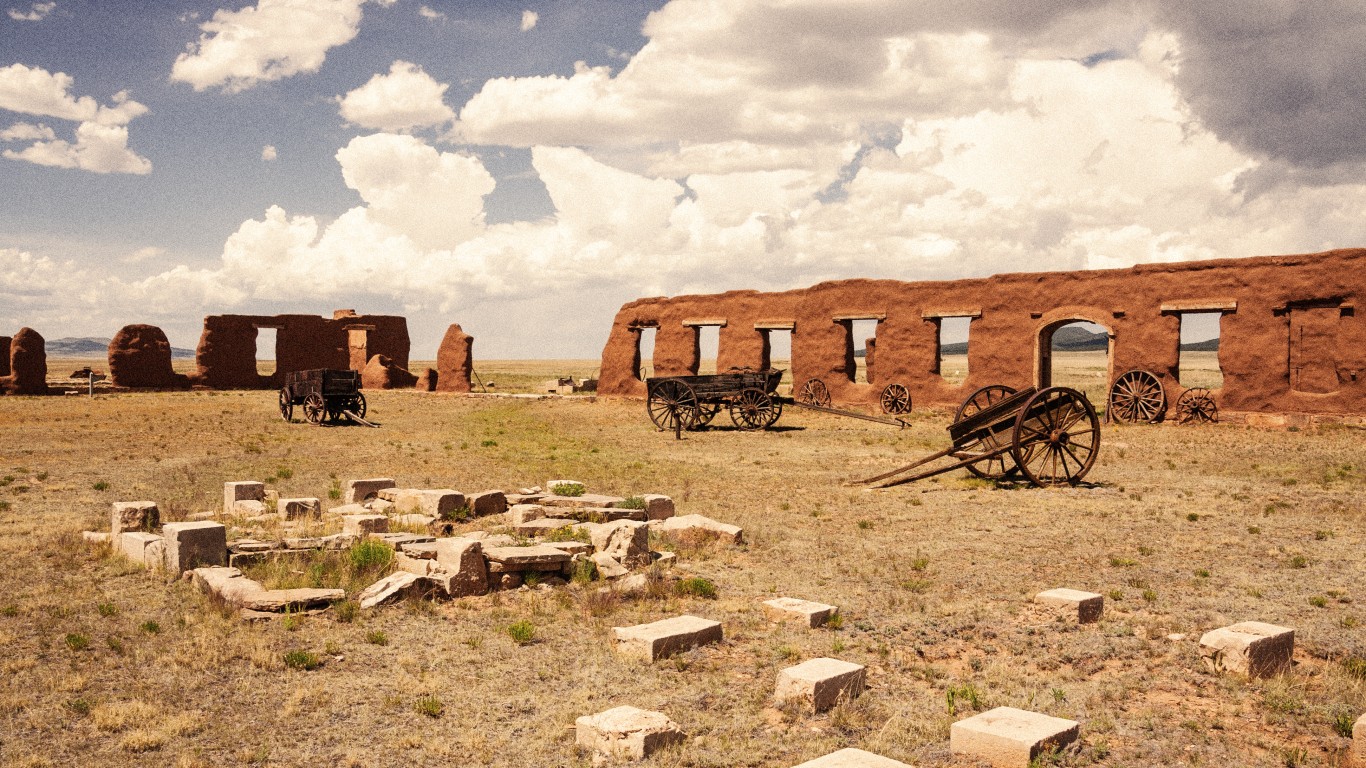
47. New Mexico
> Population: 2,115,877 (-0.1% in last year)
> Life expectancy at birth: 76.9 years (13th lowest)
> Median household income: $53,992 (6th lowest)
> Median home value: $214,000 (16th lowest)
> Median housing costs as pct. of income: 15.8% (13th lowest)
> August 2022 unemployment: 4.4% (6th highest)
New Mexico’s ranking among the five worst states to live in is largely due to the high crime rates in the state. According to the FBI, there were 778 violent crimes such as robbery and homicide reported for every 100,000 people in the state in 2020, the second highest violent crime rate in the country. Property crime like burglary and vehicle theft is also relatively common. The state’s property crime rate of 2,842 incidents per 100,000 people also ranks as the second highest of the 50 states.
Serious financial hardship is also common in New Mexico, as the state’s 18.4% poverty rate is third highest in the country. The state’s high poverty rate is partially the product of a weak job market. As of August 2022, 4.4% of the state’s labor force were unemployed, more than in the vast majority of other states and well above the 3.8% national jobless rate.
[in-text-ad-2]
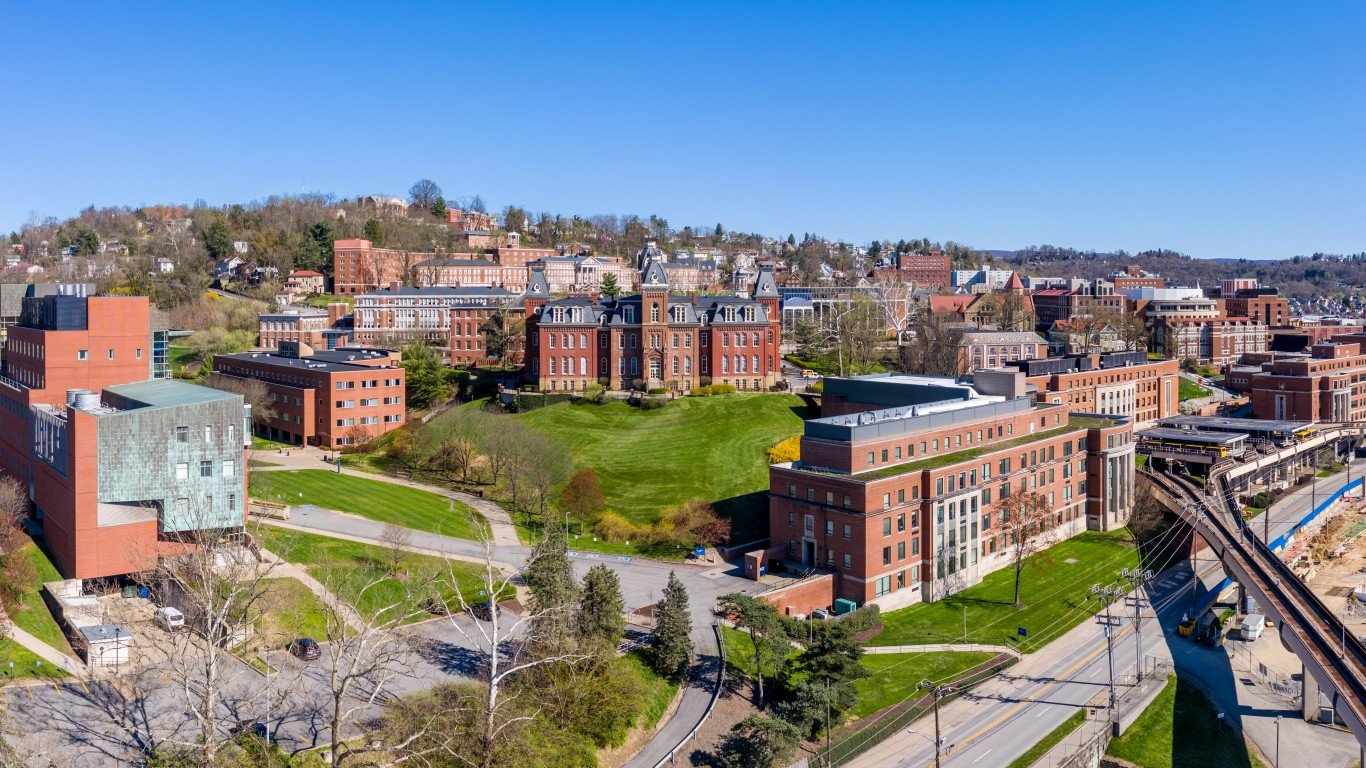
46. West Virginia
> Population: 1,782,959 (-0.6% in last year)
> Life expectancy at birth: 74.3 years (2nd lowest)
> Median household income: $51,248 (2nd lowest)
> Median home value: $143,200 (the lowest)
> Median housing costs as pct. of income: 13.4% (the lowest)
> August 2022 unemployment: 4.3% (8th highest)
With a median household income of just $51,248 and a 16.8% poverty rate, West Virginia is one of the poorest states in the country. For context, the typical household nationwide earns $69,717 a year and 12.8% of the U.S. population live below the poverty line. The state’s low incomes are partially attributable to a lack of employment opportunities. As of August 2022, 4.4% of the state’s labor force were unemployed, more than in the vast majority of other states and well above the 3.8% national jobless rate.
Though the state benefits from a low cost of living, economic conditions are likely making the state a less attractive destination for college-educated workers looking to relocate. Only 0.6% of all adults in West Virginia have a bachelor’s degree and moved there in 2021 – the smallest such share in the country.
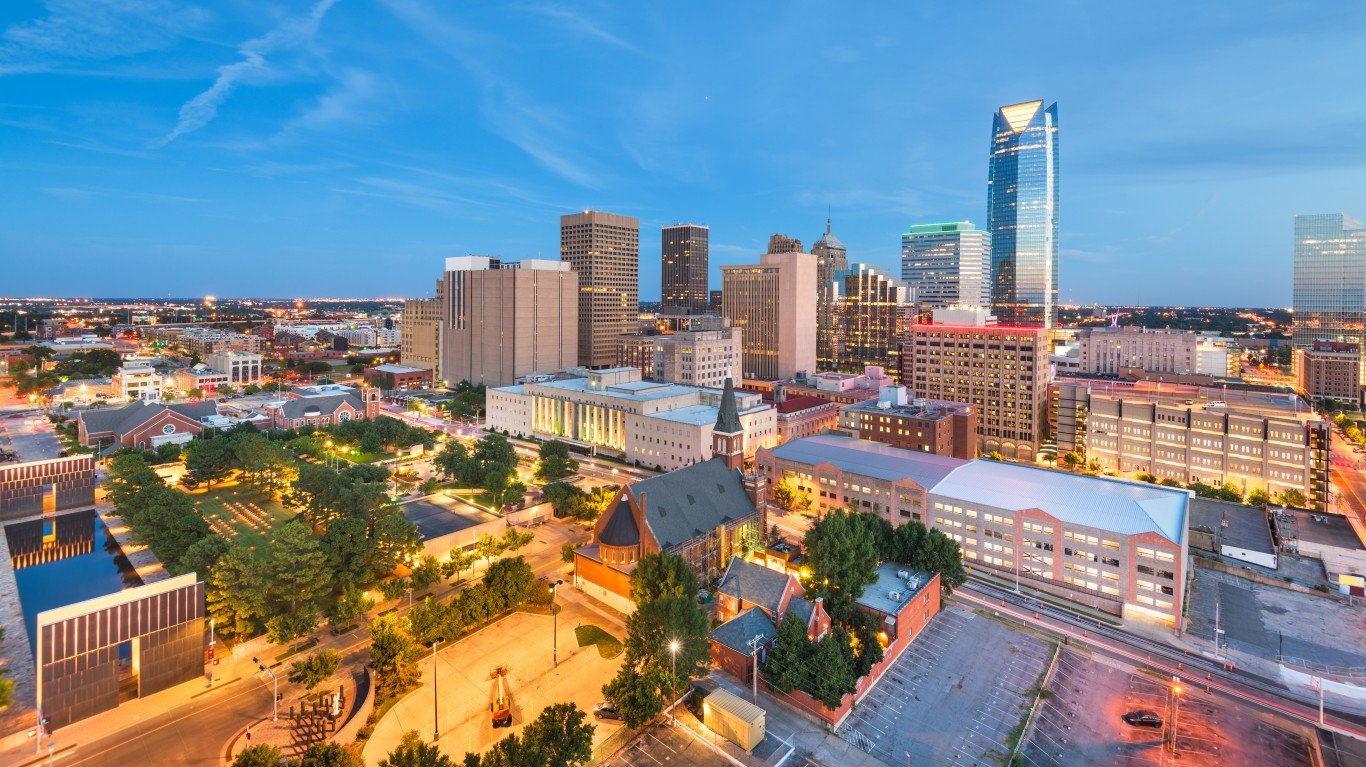
45. Oklahoma
> Population: 3,986,639 (+0.7% in last year)
> Life expectancy at birth: 75.5 years (8th lowest)
> Median household income: $55,826 (8th lowest)
> Median home value: $168,500 (4th lowest)
> Median housing costs as pct. of income: 15.4% (7th lowest)
> August 2022 unemployment: 3.4% (23rd lowest)
Oklahoma ranks as the sixth worst state to live in nationwide and the fifth worst in the South. Its low ranking is due in part to poor air quality, based on the high concentration of PM 2.5. Long-term exposure to this type of inhalable particulate matter can reduce lung function and increase the risk of mortality from lung cancer and heart disease. Oklahoma has an average of 40.2 micrograms of PM 2.5 per cubic meter of air each day – the sixth highest concentration of all states.
Oklahoma also does not appear to invest in many public amenities that can improve overall quality of life. For example, only about 65% of the population have easy access to places for physical activity like parks and recreation centers, well below the 80% share of Americans nationwide. Additionally, Oklahoma has one of the worst funded public school systems in the country. Per pupil spending across Oklahoma school districts totals just $9,144 a year, nearly the least of any state.
[in-text-ad]

44. Tennessee
> Population: 6,975,218 (+0.9% in last year)
> Life expectancy at birth: 75.3 years (6th lowest)
> Median household income: $59,695 (10th lowest)
> Median home value: $235,200 (22nd lowest)
> Median housing costs as pct. of income: 15.8% (13th lowest)
> August 2022 unemployment: 3.5% (24th highest)
Quality of life in many parts of Tennessee is undermined by high crime rates. According to the FBI, there were 673 violent crimes – such as murder, aggravated assault, and robbery – for every 100,000 people in the state in 2020, the third highest violent crime rate among all states. Additionally, Tennessee’s property crime rate, which includes offenses such as burglary and motor vehicle theft, ranks as the 10th highest among states.
While Tennessee residents benefit from a lower-than-average cost of living, incomes in the state are also below average. With a median household income of $59,695, Tennessee is one of only 10 states where most households earn less than $60,000 a year.
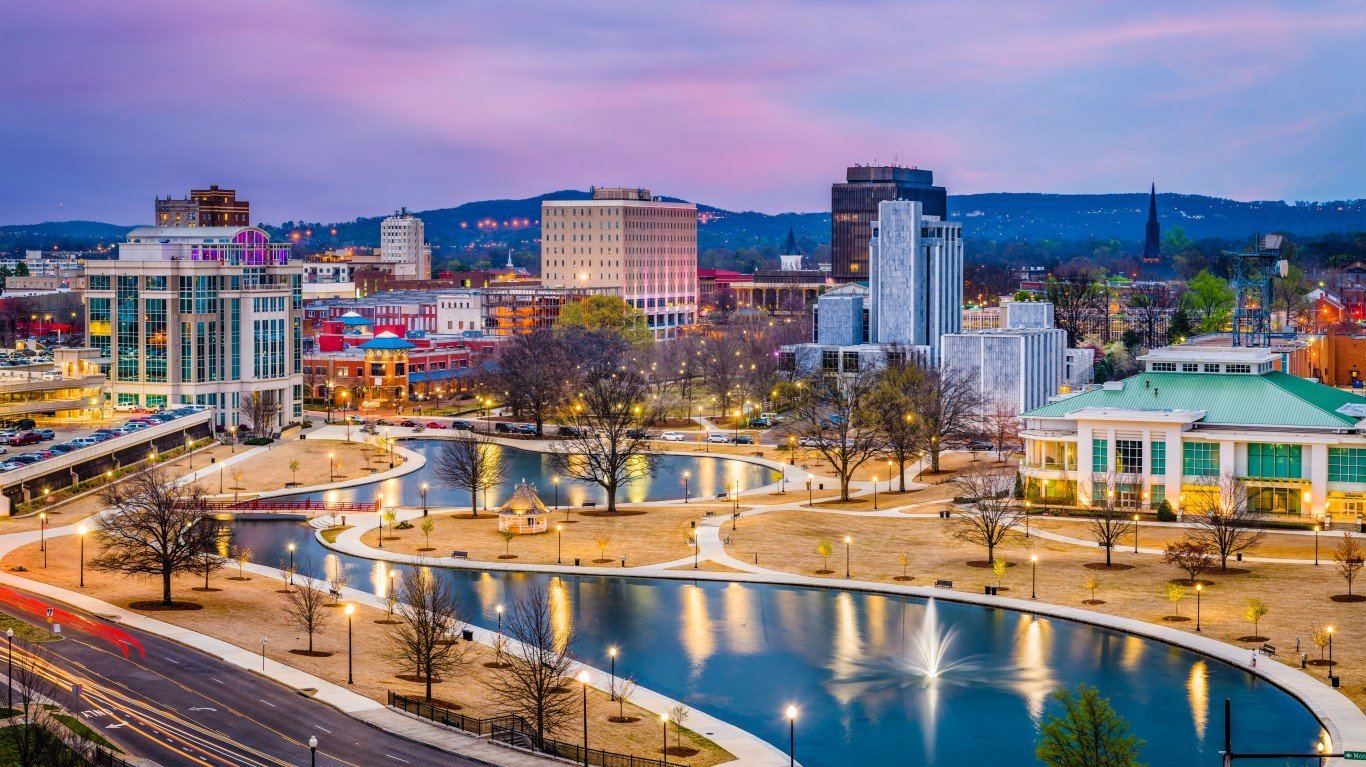
43. Alabama
> Population: 5,039,877 (+0.3% in last year)
> Life expectancy at birth: 74.8 years (3rd lowest)
> Median household income: $53,913 (5th lowest)
> Median home value: $172,800 (5th lowest)
> Median housing costs as pct. of income: 14.8% (3rd lowest)
> August 2022 unemployment: 2.9% (13th lowest)
Property values can be indicative of a given area’s desirability – and with a median home value of just $172,800, Alabama is one of only 13 states where most homes are worth less than $200,000. Financial hardship hampers quality of life for many residents in the state. The state’s poverty rate of 16.1% is well above the national poverty rate of 12.8%. Financial insecurity is likely worse for women in the state than it is for men, as Alabama also has one of the worst gender pay gaps in the country, with women getting paid 75 cents to every dollar men earn.
Across broad populations, average life expectancy is a key outcome indicator that can reveal deficiencies in access to health care, nutrition, and other services that support a healthy lifestyle. In Alabama, average life expectancy at birth is just 74.8 years, the third lowest of any state. Indeed, the state has a higher than average uninsured rate and residents are far less likely than most Americans to have easy access to places for physical exercise, like parks and recreation centers.

42. Kentucky
> Population: 4,509,394 (+0.1% in last year)
> Life expectancy at birth: 75.1 years (4th lowest)
> Median household income: $55,573 (7th lowest)
> Median home value: $173,300 (6th lowest)
> Median housing costs as pct. of income: 15.6% (10th lowest)
> August 2022 unemployment: 3.7% (21st highest)
Kentucky ranks among the 10 worst states to live in, partially due to poor air quality. Kentucky has one of the higher concentrations among states of microscopic particulate matter, long-term exposure to which can reduce lung function and increase the risk of mortality from lung cancer and heart disease.
While Kentucky residents benefit from a lower-than-average cost of living, incomes in the state are among the lowest in the country. The typical Kentucky household earns just $55,573 a year, the seven lowest median among states. Additionally, Kentucky’s poverty rate of 16.5% is the fifth highest of any state.
[in-text-ad-2]
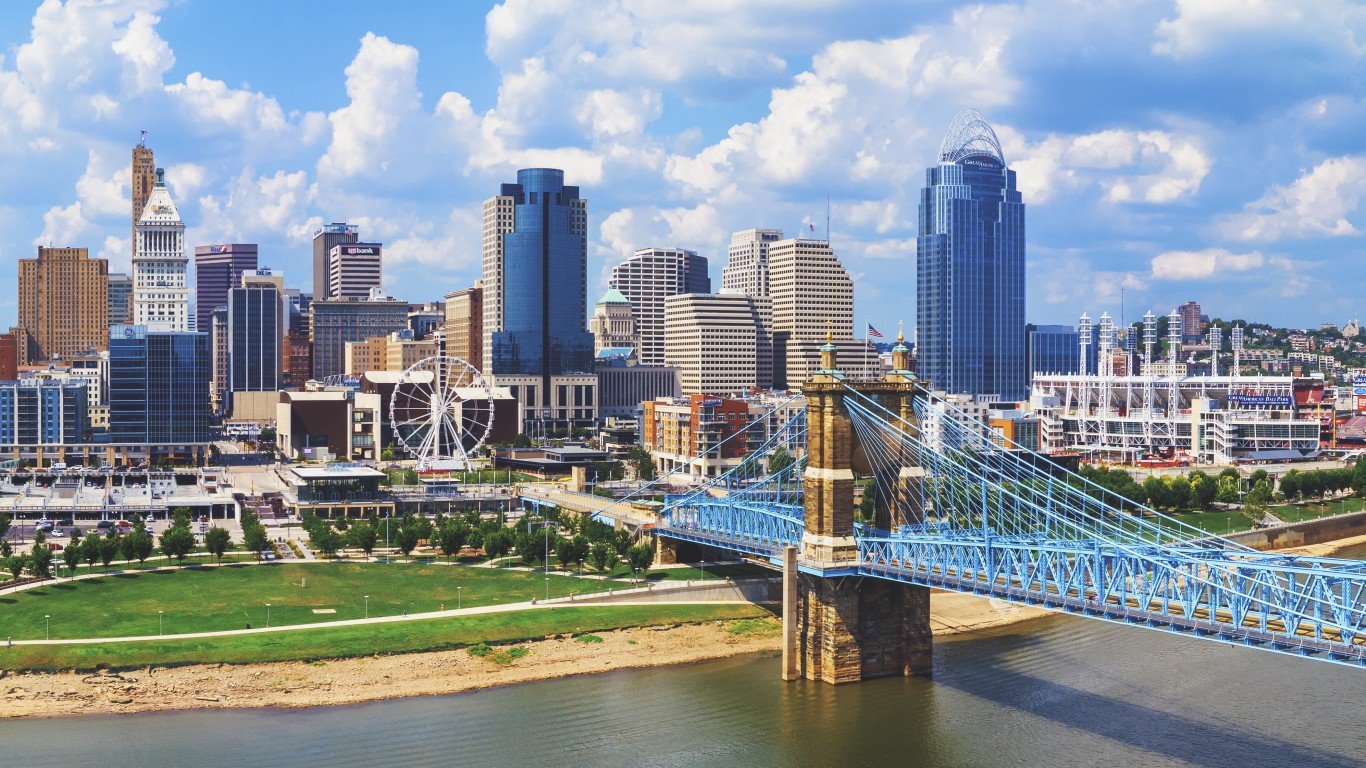
41. Ohio
> Population: 11,780,017 (-0.2% in last year)
> Life expectancy at birth: 76.5 years (11th lowest)
> Median household income: $62,262 (13th lowest)
> Median home value: $180,200 (8th lowest)
> Median housing costs as pct. of income: 15.8% (13th lowest)
> August 2022 unemployment: 4.3% (8th highest)
Ohio ranks as the worst state to live in in the Midwest and the 10th worst nationwide. Though the overall cost of living in the state is about 8% lower than the national average, incomes are also low, and some Ohio residents are facing severe financial hardships. The typical household in the state earns $62,262 a year, about $7,500 below the national median. Additionally, Ohio’s 13.4% poverty rate is the 15th highest among states.
The state’s low incomes are partially attributable to a lack of employment opportunities. As of August 2022, 4.3% of the state’s labor force were unemployed, more than in the vast majority of states and well above the 3.8% national jobless rate.

40. Missouri
> Population: 6,168,187 (+0.2% in last year)
> Life expectancy at birth: 76.6 years (12th lowest)
> Median household income: $61,847 (11th lowest)
> Median home value: $198,300 (12th lowest)
> Median housing costs as pct. of income: 15.9% (15th lowest)
> August 2022 unemployment: 3.0% (14th lowest)
Missouri ranks as the 11th worst state to live in in the United States – and the second worst in the Midwest – largely because of high crime rates. According to the FBI, there were 553 violent crimes such as robbery and homicide reported for every 100,000 people in the state in 2020, the sixth highest violent crime rate in the country. Property crime like burglary and vehicle theft is also relatively common. The state’s property crime rate of 2,531 incidents per 100,000 people is ninth highest of the 50 states.
Across broad populations, average life expectancy is a key indicator that can reveal deficiencies in access to health care, nutrition, and other services that support a healthy lifestyle. In Missouri, average life expectancy at birth is just 76.6 years, the 12th lowest of any state. The state has a higher than average uninsured rate, and residents are far less likely than most Americans to have easy access to places for physical exercise like parks and recreation centers.
[in-text-ad]
39. New York
> Population: 19,835,913 (-1.8% in last year)
> Life expectancy at birth: 80.3 years (4th highest)
> Median household income: $74,314 (14th highest)
> Median home value: $368,800 (12th highest)
> Median housing costs as pct. of income: 18.9% (9th highest)
> August 2022 unemployment: 4.9% (2nd highest)
New York is the only state in the Northeast to rank among the 15 worst states to live in. While New York has higher than average incomes and life expectancy at birth, it also has the worst income inequality in the country. New York is also one of the least affordable states to live in. Median housing costs – considering both renters and homeowners – account for 18.9% of the income the typical household earns, the ninth highest percentage among states. The overall cost of living in the state is over 10% higher than the national average.
New York’s job market is also relatively weak. At 4.9%, the state’s August 2022 unemployment rate is the second highest in the country and far higher than the 3.8% national rate. When taking into account only people moving in and out of the state, New York’s population declined by 1.9% from 2020 to 2021, the largest drop in the country.
38. North Carolina
> Population: 10,551,162 (+1.1% in last year)
> Life expectancy at birth: 77.7 years (16th lowest)
> Median household income: $61,972 (12th lowest)
> Median home value: $236,900 (23rd lowest)
> Median housing costs as pct. of income: 16.2% (16th lowest)
> August 2022 unemployment: 3.9% (17th highest)
Easy access to places for exercise like parks or recreation centers can improve overall quality of life. In North Carolina, only 67.6% of the population have such access, well below the 79.8% of Americans nationwide who do. North Carolina also invests far less in its school system than average. Spending at North Carolina public schools totals just $9,747 per pupil annually, the ninth lowest amount of any state.
Both the overall violent and property crime rates in North Carolina are higher than the national average, and burglary rates are particularly high. There were nearly 50,000 burglaries reported in the state in 2020, or 471 for every 100,000 people, the seventh highest among the 50 states.
37. Texas
> Population: 29,527,941 (+1.3% in last year)
> Life expectancy at birth: 78.4 years (24th lowest)
> Median household income: $66,963 (23rd highest)
> Median home value: $237,400 (24th lowest)
> Median housing costs as pct. of income: 17.5% (18th highest)
> August 2022 unemployment: 4.2% (12th highest)
The monthly unemployment rate in Texas is higher than in much of the country. As of August 2022, 4.2% of the labor force were unemployed, well above the 3.8% national jobless rate and the 12th highest among states. Violent crime, particularly robbery, is more common in Texas than it is in most states. The state’s overall violent crime rate of 446 per 100,000 people is 15th highest in the country, and its robbery rate – a component of the violent crime rate – stands at 91 per 100,000, sixth highest among states.
Texas also invests far less in its school system than average. Per pupil spending at Texas public schools totals just $9,697, the eighth lowest of any state.
[in-text-ad-2]
36. Illinois
> Population: 12,671,469 (-1.1% in last year)
> Life expectancy at birth: 78.6 years (24th highest)
> Median household income: $72,205 (17th highest)
> Median home value: $231,500 (21st lowest)
> Median housing costs as pct. of income: 17.8% (16th highest)
> August 2022 unemployment: 4.8% (3rd highest)
People are moving out of Illinois at a faster rate than they are moving in, causing nearly the largest population decline of any state due to migration. Considering only net migration and excluding natural growth – births minus deaths – the state’s population declined by 1.1% from 2020 to 2021, the second largest such decline of any state, trailing only New York.
There are several potential factors that may be contributing to the state’s population decline. For one, Illinois residents spend a larger share of their income on housing – including taxes – than residents in most states. Illinois also has the third highest monthly unemployment rate among states, at 4.8% as of August 2022, a full percentage point higher than the national rate. Certain social factors, like high crime, also take away from quality of life in the state. Illinois has the eighth highest homicide rate in the country and the fourth highest robbery rate.
35. South Carolina
> Population: 5,190,705 (+1.4% in last year)
> Life expectancy at birth: 76.4 years (9th lowest)
> Median household income: $59,318 (9th lowest)
> Median home value: $213,500 (15th lowest)
> Median housing costs as pct. of income: 15.5% (9th lowest)
> August 2022 unemployment: 3.2% (20th lowest)
Crime is a bigger problem in South Carolina than it is in most other states. According to the FBI, there were 531 violent crimes such as robbery and homicide reported for every 100,000 people in the state in 2020, the seventh highest violent crime rate in the country. Property crime like burglary and vehicle theft is also relatively common. The state’s property crime rate of 2,721 incidents per 100,000 people ranks as the fifth highest of the 50 states.
Crime is often more concentrated in areas with poorer socioeconomic conditions – and South Carolina’s poverty rate of 14.6% is among the 10 highest of all states. Both crime and poverty are linked to lower life expectancy, and average life expectancy at birth in the state is just 76.4 years, about two years below the national average.
[in-text-ad]
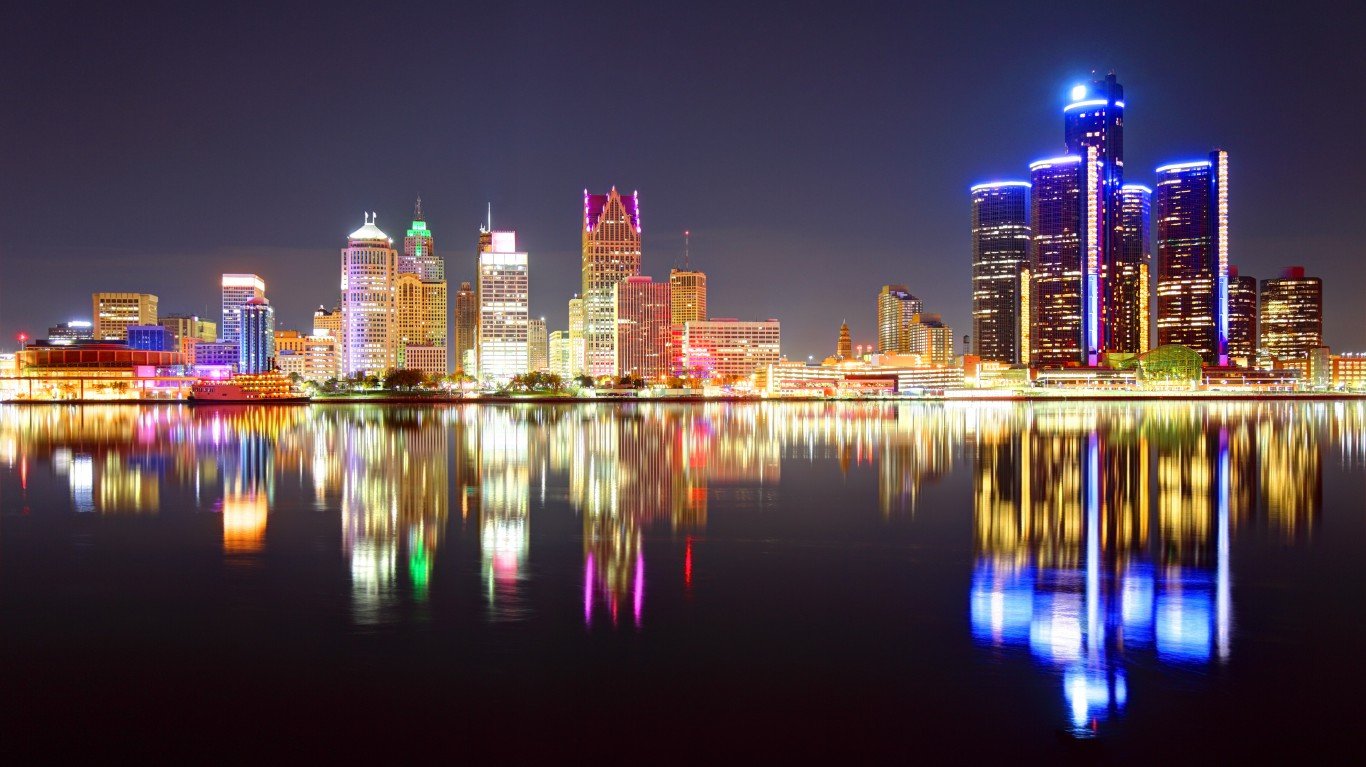
34. Michigan
> Population: 10,050,811 (-0.3% in last year)
> Life expectancy at birth: 77.5 years (15th lowest)
> Median household income: $63,498 (17th lowest)
> Median home value: $199,100 (13th lowest)
> Median housing costs as pct. of income: 16.5% (22nd lowest)
> August 2022 unemployment: 4.0% (16th highest)
Criminal violence is more common in Michigan than it is in most other states. There were over 47,600 violent crimes reported in the state in 2020, or 478 incidents per 100,00 people, the 10th highest violent crime rate of any state. Michigan also lags behind much of the country in several other key measures. Unemployment and poverty rates are slightly higher than average in Michigan, and the state’s median household income of $63,498 is about $6,000 less than the national median.
Property values can be an indication of a place’s desirability, and with a median home value of $199,100, Michigan is one of only 13 states where most homes are worth less than $200,000.
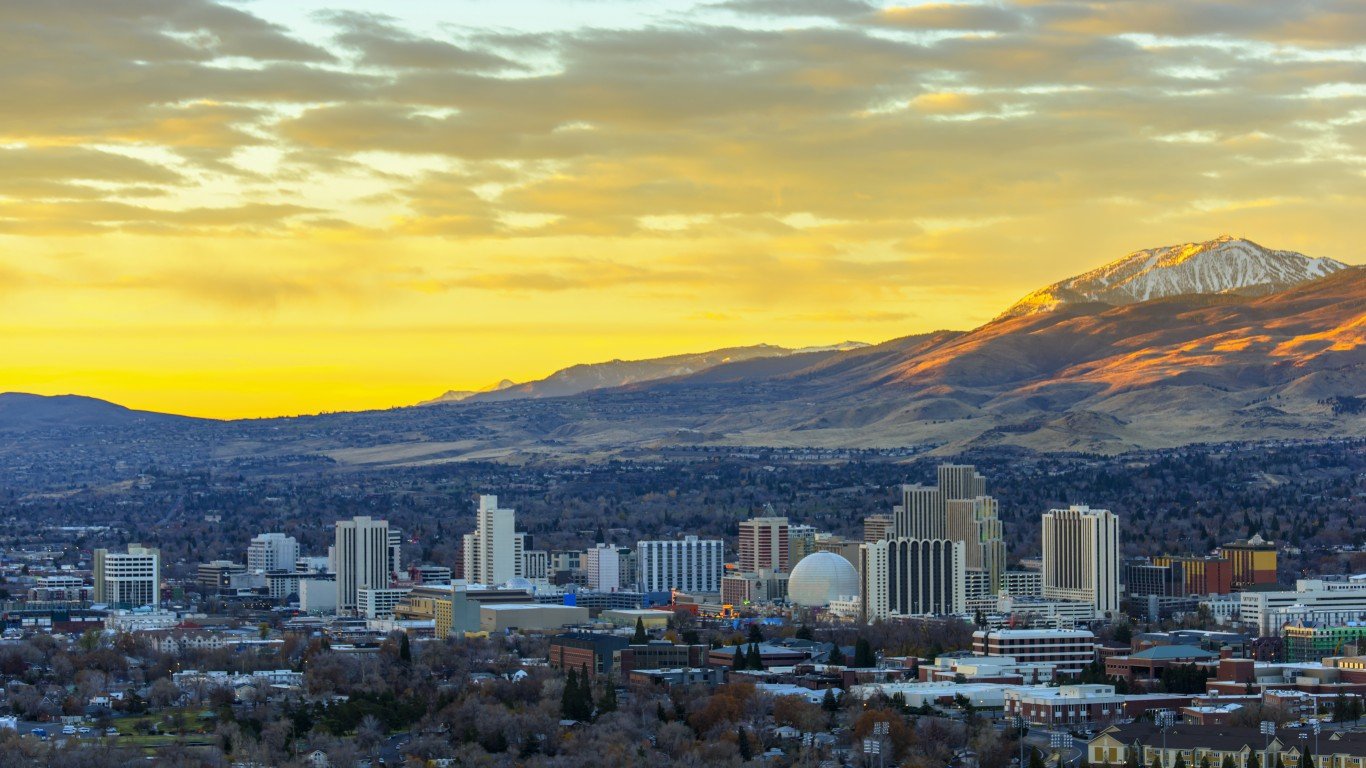
33. Nevada
> Population: 3,143,991 (+1.3% in last year)
> Life expectancy at birth: 78.1 years (21st lowest)
> Median household income: $66,274 (23rd lowest)
> Median home value: $373,000 (9th highest)
> Median housing costs as pct. of income: 18.1% (14th highest)
> August 2022 unemployment: 5.2% (the highest)
Nevada ranks as the 18th worst state to live in nationwide but only the second worst state in the West. The state’s ranking is due in large part to its job market, as Nevada’s August 2022 unemployment rate of 5.2% is the highest of any state. Nevada’s housing market is also less affordable than average. Median housing costs – considering both renters and homeowners – account for 18.1% of the income the typical household earns, compared to the 17.4% national ratio.
Nevada’s relatively high violent crime rate also reduces overall quality of life in the state. There were over 14,400 violent crimes reported in the state in 2020, or 460 per 100,00 people, the 12th highest violent crime rate of any state. Nevada also has relatively poor air quality, with one of the higher concentrations of microscopic particulate matter, which can reduce lung function and increase the risk of mortality from lung cancer and heart disease with long-term exposure.
32. Pennsylvania
> Population: 12,964,056 (-0.3% in last year)
> Life expectancy at birth: 78.0 years (19th lowest)
> Median household income: $68,957 (21st highest)
> Median home value: $222,300 (18th lowest)
> Median housing costs as pct. of income: 16.3% (18th lowest)
> August 2022 unemployment: 4.8% (3rd highest)
Pennsylvania ranks among the 20 worst states to live in, partially due to environmental conditions. The state gets less sunlight than all but eight other states. Additionally, air quality as measured by the concentration of microscopic particulate matter that can cause serious health conditions is worse in Pennsylvania than in all but seven other states.
Some key economic conditions are also below average in Pennsylvania. The state has the third highest unemployment rate in the country, at 4.8% as of August 2022, a full percentage point higher than the national rate.
[in-text-ad-2]
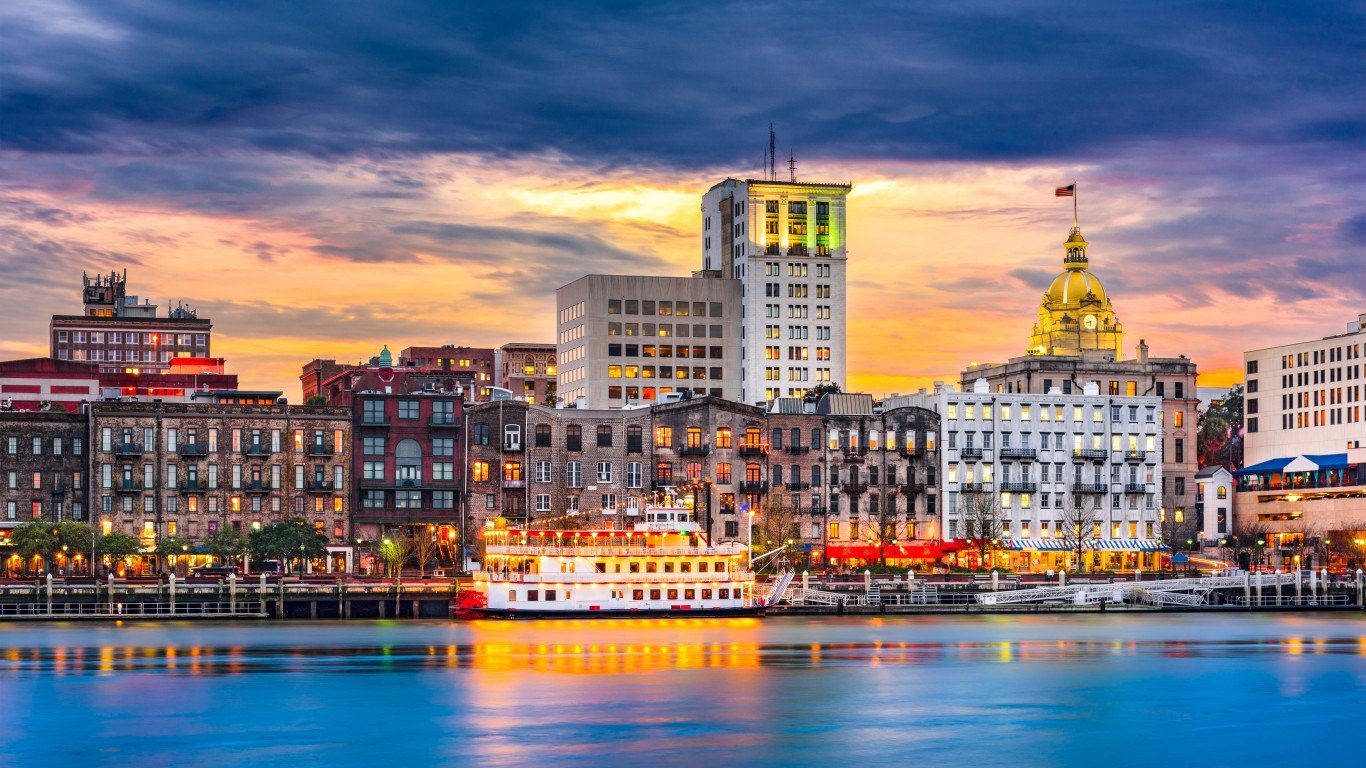
31. Georgia
> Population: 10,799,566 (+0.8% in last year)
> Life expectancy at birth: 77.3 years (14th lowest)
> Median household income: $66,559 (25th highest)
> Median home value: $249,700 (25th lowest)
> Median housing costs as pct. of income: 16.4% (20th lowest)
> August 2022 unemployment: 3.1% (18th lowest)
Georgia ranks in the lower half of the 50 states as a place to live based on several key measures. For one, only 69.8% of the state’s population have easy access to places for physical exercise, like parks or recreation centers, a smaller share than in most states and well below the 79.8% share of Americans nationwide.
Georgia residents are also more likely than most Americans to struggle with serious financial hardship. The state’s poverty rate of 14.0% is 12th highest in the country and above the 12.8% national poverty rate.
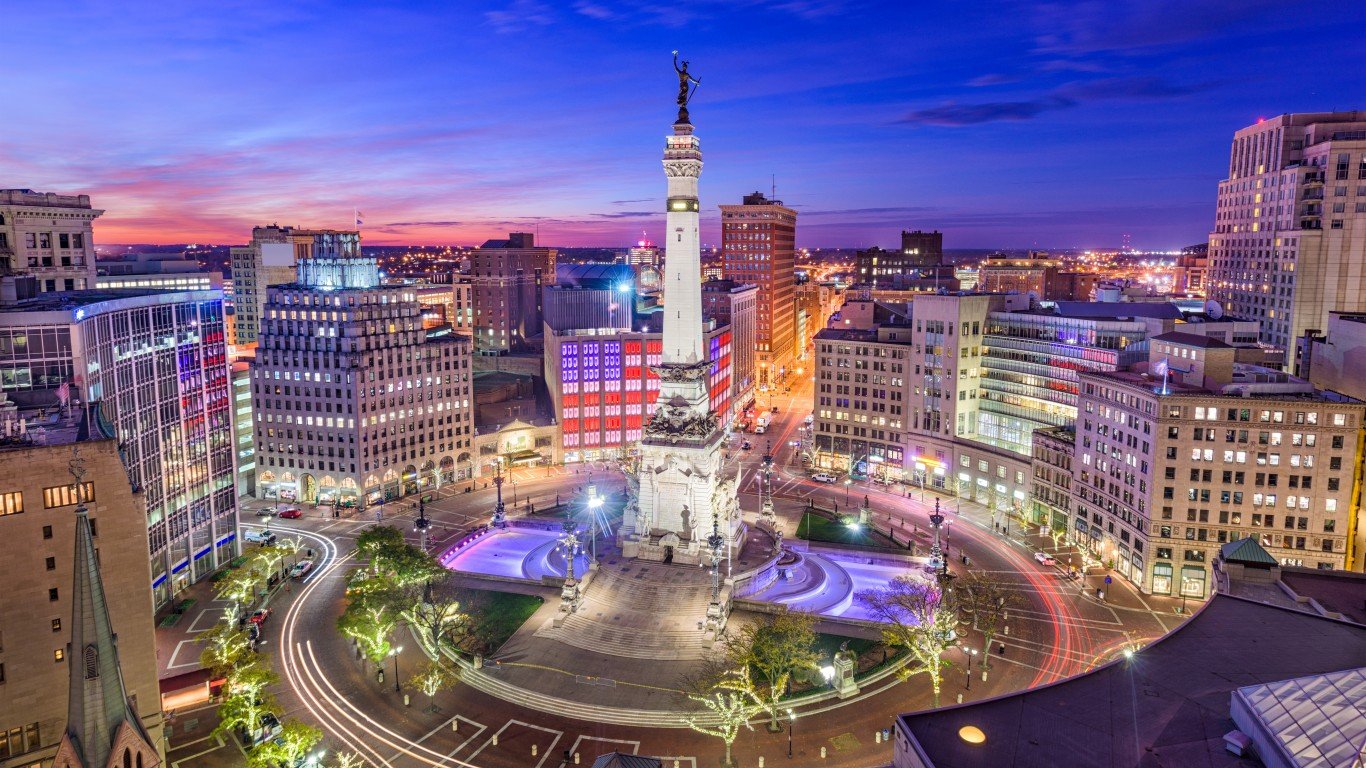
30. Indiana
> Population: 6,805,985 (+0.3% in last year)
> Life expectancy at birth: 76.5 years (10th lowest)
> Median household income: $62,743 (14th lowest)
> Median home value: $182,400 (9th lowest)
> Median housing costs as pct. of income: 15.2% (6th lowest)
> August 2022 unemployment: 3.1% (18th lowest)
Though less favorable as a place to live than most states, Indiana ranks near the middle of the 50 states for quality of life. State residents benefit from a low cost of living, with goods and services costing about 7.5% less than average. Housing is particularly affordable, with median housing costs – considering both renters and homeowners – accounting for just 15.2% of the income the typical household earns, compared to the 17.4% national ratio.
In some key environmental measures, however, Indiana lags behind much of the country, with worse air quality and less sunlight than most states. Indiana also invests far less in its school system than average. Spending at Indiana public schools totals just $10,137 per pupil annually, the 12th lowest amount of any state.
[in-text-ad]
29. California
> Population: 39,237,836 (-0.8% in last year)
> Life expectancy at birth: 81.0 years (2nd highest)
> Median household income: $84,907 (5th highest)
> Median home value: $648,100 (2nd highest)
> Median housing costs as pct. of income: 21.0% (the highest)
> August 2022 unemployment: 4.1% (14th highest)
California has the least affordable housing market of any state in the country. Median housing costs – considering both renters and homeowners – account for 21.0% of the income the typical household earns, compared to the 17.4% average housing cost-to-income ratio nationwide. The lack of affordable housing may be pushing many out of the state. Considering only net migration and excluding natural growth – births minus deaths – the state’s population declined by 1.1% from 2020 to 2021, the third largest such decline of any state, trailing only New York and Illinois. California also has higher unemployment and higher crime rates than most other states.
Still, California residents benefit from well-funded public amenities and services. For example, nearly 93% of the state’s population live in close proximity to a place for physical exercise, such as a park or recreation center, the largest share of any state and well above the 79.8% national share. Additionally, California spends an average of $13,679 annually per pupil on its public school system, more than most other states.
28. Kansas
> Population: 2,934,582 (-0.1% in last year)
> Life expectancy at birth: 77.8 years (17th lowest)
> Median household income: $64,124 (18th lowest)
> Median home value: $183,800 (10th lowest)
> Median housing costs as pct. of income: 16.3% (18th lowest)
> August 2022 unemployment: 3.1% (18th lowest)
Kansas ranks close to the middle of all states for overall quality of life. While incomes are slightly lower than average in Kansas — the state’s median household income of $64,124 a year is about $5,600 below the national median — the cost of living in the state is relatively low. Goods and services in Kansas are about 7.6% less expensive than they are nationwide on average.
Other key socioeconomic measures are also mixed in Kansas. For one, the state’s job market is relatively strong with an August 2022 unemployment rate of only 3.1%, well below the 3.8% national jobless rate. However, both property and violent crime rates in the state are slightly higher than the national average.

27. South Dakota
> Population: 895,376 (+1.0% in last year)
> Life expectancy at birth: 78.2 years (22nd lowest)
> Median household income: $66,143 (22nd lowest)
> Median home value: $219,900 (17th lowest)
> Median housing costs as pct. of income: 16.4% (20th lowest)
> August 2022 unemployment: 2.4% (7th lowest)
South Dakota is one of the more affordable states to live in. Goods and services in the state are about 8.5% less expensive on average than they are nationwide. Housing is particularly affordable in relation to income. Median housing costs – considering both renters and homeowners – account for just 16.4% of the income the typical household earns, compared to the 17.4% average housing cost-to-income ratio nationwide.
Still, there are also some glaring drawbacks to overall quality of life in South Dakota. The state’s violent crime rate of 501 incidents per 100,000 people is the eighth highest in the country. Additionally, only 66% of the state’s population live in close proximity to places for physical exercise, such as parks, compared to 79.8% of Americans nationwide.
[in-text-ad-2]
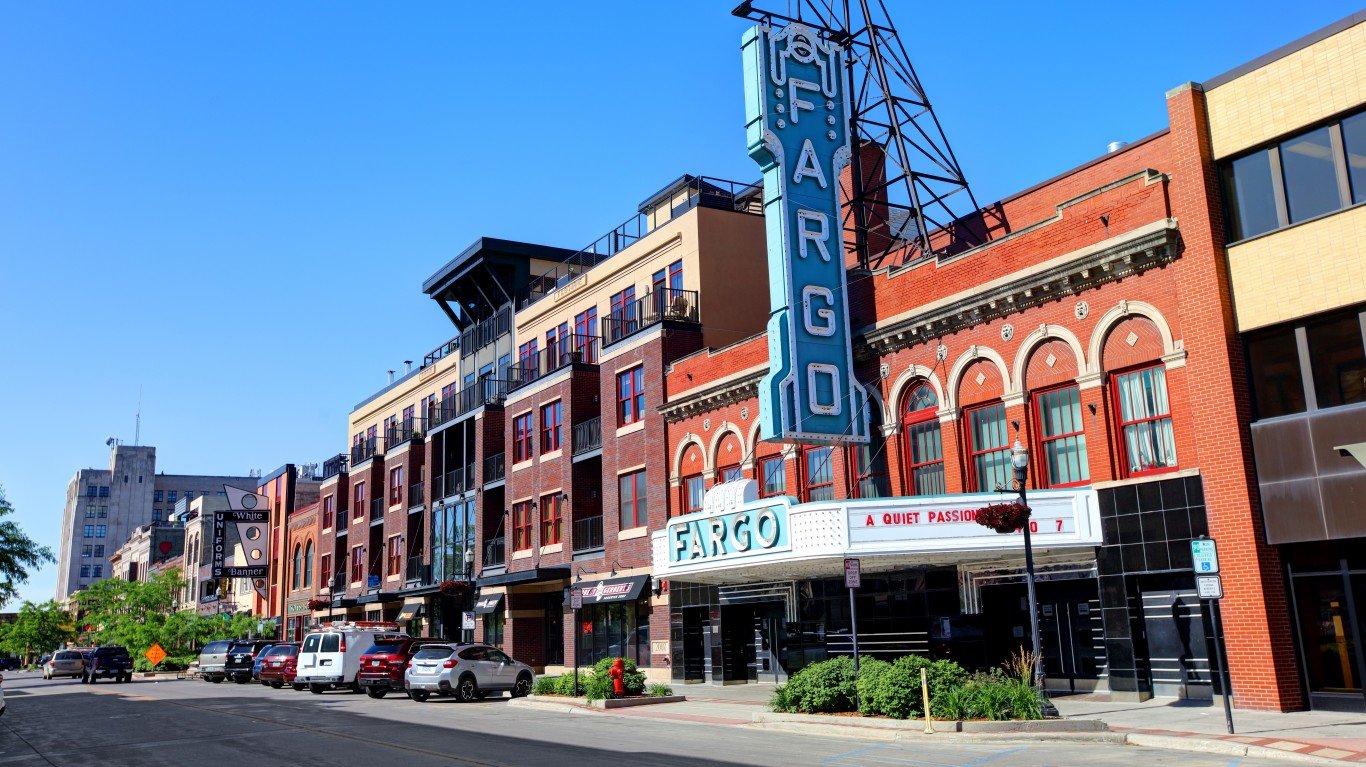
26. North Dakota
> Population: 774,948 (-0.5% in last year)
> Life expectancy at birth: 78.8 years (21st highest)
> Median household income: $66,519 (25th lowest)
> Median home value: $224,400 (19th lowest)
> Median housing costs as pct. of income: 15.0% (4th lowest)
> August 2022 unemployment: 2.2% (5th lowest)
Like its neighbor South Dakota, North Dakota ranks close to the middle of all states for overall quality of life. State residents benefit from a strong job market with an August 2022 jobless rate of just 2.2%, one of the lowest in the country and well below the 3.8% national rate. And while the state’s median household income of $66,519 is about $3,000 below the national median, poverty is less common in the state than it is nationwide. The state’s poverty rate of 11.1% is lower than in most other states and below the 12.8% national poverty rate.
North Dakota is not without some disadvantages, however. For one, the state gets less sunlight than most parts of the country. Additionally, only 64.4% of the state’s population live in close proximity to places for physical exercise, such as parks or recreation centers, compared to 79.8% of all Americans nationwide.

25. Alaska
> Population: 732,673 (-0.1% in last year)
> Life expectancy at birth: 78.6 years (23rd highest)
> Median household income: $77,845 (12th highest)
> Median home value: $304,900 (19th highest)
> Median housing costs as pct. of income: 17.8% (16th highest)
> August 2022 unemployment: 3.5% (24th highest)
The typical household in Alaska earns $77,845, more than in most states. Still, the cost of living in the state – particularly housing – is also higher than average. Median housing costs – considering both renters and homeowners – account for 17.8% of the income the typical household earns, compared to the 17.4% national ratio. Still, Alaskans benefit from a relatively strong job market, with an unemployment rate of just 3.5%, below the 3.8% national average.
Perhaps the most significant detractor to overall quality of life in Alaska is the prevalence of violent crime. There were 838 violent crimes in the state for every 100,000 people in 2020, the most of any state and more than double the national rate of 399 violent crimes per 100,000 people.
[in-text-ad]

24. Oregon
> Population: 4,246,155 (+0.2% in last year)
> Life expectancy at birth: 79.7 years (10th highest)
> Median household income: $71,562 (18th highest)
> Median home value: $422,700 (6th highest)
> Median housing costs as pct. of income: 19.1% (7th highest)
> August 2022 unemployment: 4.3% (8th highest)
Oregon ranks near the middle of all states for overall quality of life. At $71,562, the state’s median household income is higher than in most states. However, the cost of living is also higher than average, particularly housing. Median housing costs – considering both renters and homeowners – account for 19.1% of the income the typical household earns, seventh highest among states and above the 17.4% national ratio. Oregon also has a relatively weak job market, with an August 2022 jobless rate of 4.3% – eighth highest among states.
While violent crimes like homicide and aggravated assault are less common in Oregon than they are nationwide, the same cannot be said of property crime such as burglary and motor vehicle theft. The state’s property crime rate stands at 2,659 incidents per 100,000, higher than in all but six other states.
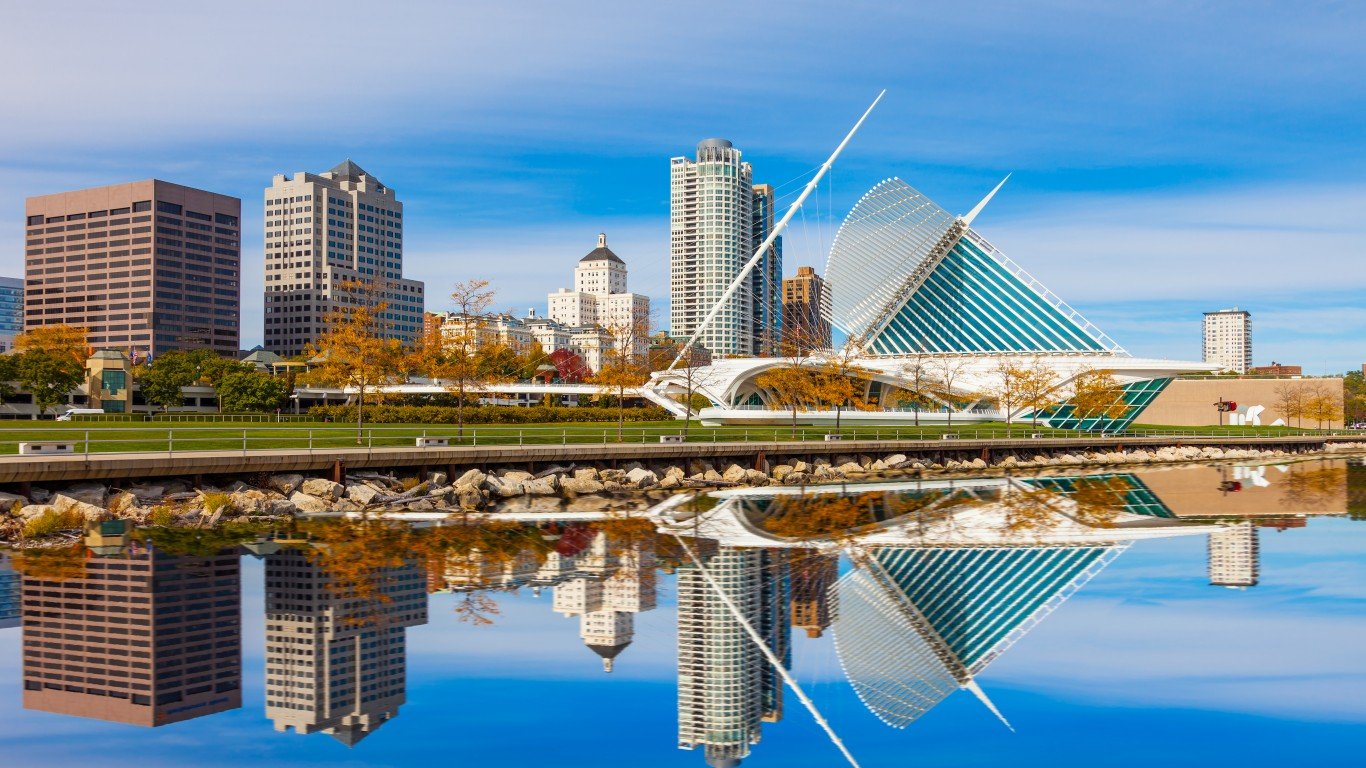
23. Wisconsin
> Population: 5,895,908 (+0.0% in last year)
> Life expectancy at birth: 78.9 years (20th highest)
> Median household income: $67,125 (22nd highest)
> Median home value: $230,700 (20th lowest)
> Median housing costs as pct. of income: 17.0% (22nd highest)
> August 2022 unemployment: 3.3% (22nd lowest)
Wisconsin ranks close to the middle of all states for overall quality of life. While the state gets less sunlight than most on average, it also has some of the cleanest air in the United States. It has one of the lower concentrations among states of microscopic particulate matter, which can reduce lung function and increase the risk of mortality from lung cancer and heart disease with long-term exposure.
Home values can be indicative of a place’s desirability, and in Wisconsin, the typical home is worth $230,700, $50,700 less than the typical American home nationwide. Still, at a time when income inequality is soaring in the United States, Wisconsin has some of the lowest income inequality nationwide. Additionally, the state’s August 2022 jobless rate of 3.3% is half a percentage point lower than the national rate.

22. Arizona
> Population: 7,276,316 (+1.7% in last year)
> Life expectancy at birth: 79.1 years (18th highest)
> Median household income: $69,056 (20th highest)
> Median home value: $336,300 (15th highest)
> Median housing costs as pct. of income: 16.9% (23rd highest)
> August 2022 unemployment: 4.2% (12th highest)
Arizona is one of the fastest growing states in the country. Considering only net migration and excluding natural growth – births minus deaths – the state’s population expanded by 1.7% from 2020 to 2021, the third largest such increase of any state. The state’s attractiveness to newcomers may include its warm climate and the fact that it gets more sunlight, on average, than every other state. Other reasons may also be related to affordability. While home values are higher than average in Arizona, residents pay a smaller than typical share of their income for housing annually.
Arizona is not without some notable drawbacks, however. The state’s August jobless rate, for example, stands at 4.2%, well above the 3.8% national rate. Arizona also has higher rates of criminal violence than most of the country. With 485 violent crimes reported in the state for every 100,000 people in 2020, the state has one of the 10 highest violent crime rates nationwide.
[in-text-ad-2]
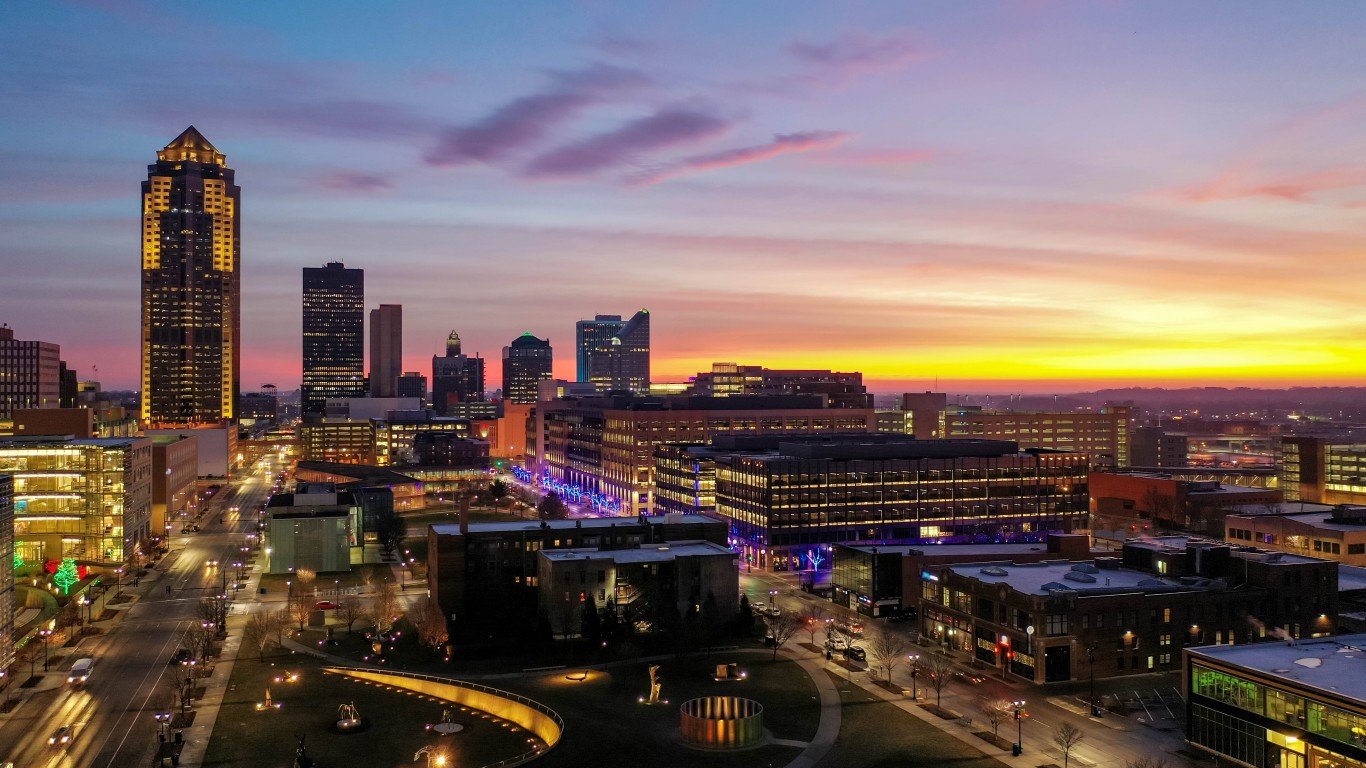
21. Iowa
> Population: 3,193,079 (+0.1% in last year)
> Life expectancy at birth: 78.7 years (22nd highest)
> Median household income: $65,600 (21st lowest)
> Median home value: $174,400 (7th lowest)
> Median housing costs as pct. of income: 15.9% (15th lowest)
> August 2022 unemployment: 2.9% (13th lowest)
Iowa ranks as the 21st best state to live in nationwide and the third best state in the Midwest. Though incomes in the state are generally lower than average, so, too, is the cost of living, particularly housing. Median housing costs – considering both renters and homeowners – account for only 15.9% of the income the typical household earns, below the 17.4% national ratio. Iowa also has a relatively strong job market, with only a 2.9% unemployment rate as of August 2022.
In some other key measures, however, Iowa lags behind much of the country. The state invests less in its school system than average, spending just $11,271 per pupil annually, the 20th lowest amount of any state. Additionally, only 72.7% of Iowa’s population have easy access to places for exercise, such as parks and recreation centers, compared to 79.8% of all Americans.
20. Montana
> Population: 1,104,271 (+1.8% in last year)
> Life expectancy at birth: 78.4 years (23rd lowest)
> Median household income: $63,249 (16th lowest)
> Median home value: $322,800 (17th highest)
> Median housing costs as pct. of income: 16.9% (23rd highest)
> August 2022 unemployment: 2.6% (8th lowest)
In key measures of quality of life, Montana ranks in the better half of the 50 states. While the state gets less sunlight, on average, than most other states, it also has some of the cleanest air in the United States. It has one of the lower concentrations among states of microscopic particulate matter, long-term exposure to which can reduce lung function and increase the risk of mortality from lung cancer and heart disease.
Montana also compares favorably in certain economic measures. Though the state’s median household income of $63,249 is about $6,500 below the national median, its poverty rate of 11.9% is nearly a full percentage point below the national poverty rate of 12.8%. Montana’s job market is also relatively strong, with an August unemployment rate of only 2.6%, compared to the 3.8% national jobless rate.
[in-text-ad]

19. Washington
> Population: 7,738,692 (+0.4% in last year)
> Life expectancy at birth: 80.2 years (5th highest)
> Median household income: $84,247 (7th highest)
> Median home value: $485,700 (3rd highest)
> Median housing costs as pct. of income: 18.9% (9th highest)
> August 2022 unemployment: 4.1% (14th highest)
Home values can be indicative of an area’s desirability, and in Washington state, the typical home is worth $485,700, more than the typical home value in all but two other states. Incomes are also high in the state, with the typical household earning $84,247 a year, about $14,500 more than the national median household income.
Washington also has some of the cleanest air in the country, with relatively low concentrations of harmful, microscopic particulate matter. Factors like high incomes and low levels of air pollution are linked to better health outcomes across broad populations. In Washington, average life expectancy at birth is 80.2 years, fifth highest among states.

18. Florida
> Population: 21,781,128 (+1.1% in last year)
> Life expectancy at birth: 79.7 years (11th highest)
> Median household income: $63,062 (15th lowest)
> Median home value: $290,700 (21st highest)
> Median housing costs as pct. of income: 18.4% (13th highest)
> August 2022 unemployment: 2.8% (10th lowest)
Florida ranks among the better half of all states for overall quality of life and it ranks as one of the best states to live in in the South. It has a warm climate and gets more sun, on average, than nearly every other state. The state’s job market is relatively strong, with an unemployment rate of just 2.8% as of August 2022, a full percentage point below the national rate. Florida is also growing its population rapidly. Considering only net migration and excluding natural growth – births minus deaths – the state’s population expanded by 1.4% from 2020 to 2021, the sixth largest such increase of any state.
Still, Florida is not without some drawbacks, namely, a less affordable housing market. The state has a lower than average median household income and a higher than average median home value, and median housing costs – considering both renters and homeowners – account for 18.4% of the income the typical household earns, above the 17.4% national ratio.
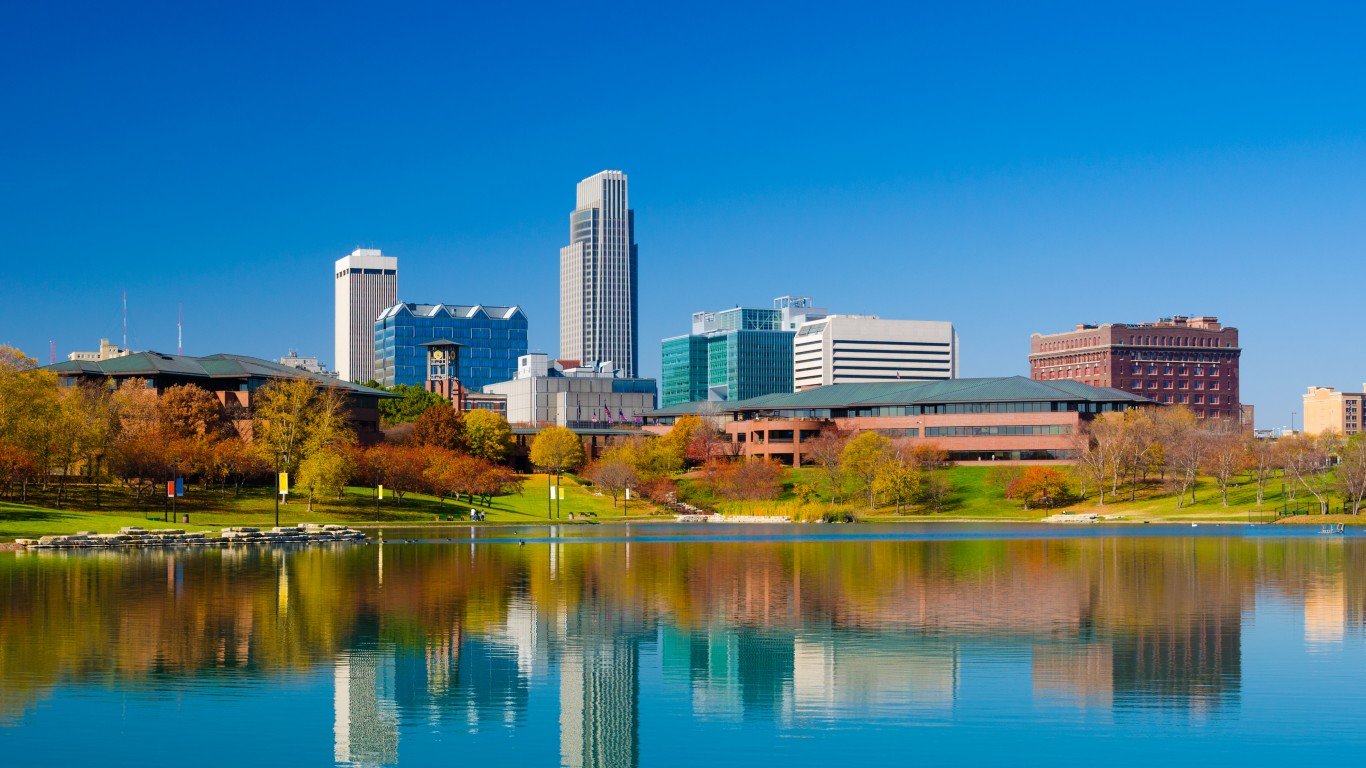
17. Nebraska
> Population: 1,963,692 (+0.1% in last year)
> Life expectancy at birth: 79.0 years (19th highest)
> Median household income: $66,817 (24th highest)
> Median home value: $204,900 (14th lowest)
> Median housing costs as pct. of income: 16.5% (22nd lowest)
> August 2022 unemployment: 2.2% (5th lowest)
Nebraska ranks as the second best state for quality of life in the Midwest, trailing only Minnesota. The state has some of the cleanest air, on average, with low concentrations of harmful particulate matter. The state is also affordable, with residents spending a smaller than typical share of their income on housing. Overall, goods and services are about 7% less expensive in the state than they are nationwide.
Nebraska’s job market is also relatively strong, with just 2.2% of the labor force out of work in August 2022, well below the 3.8% national jobless rate that month.
[in-text-ad-2]
16. Delaware
> Population: 1,003,384 (+1.4% in last year)
> Life expectancy at birth: 78.0 years (18th lowest)
> Median household income: $71,091 (19th highest)
> Median home value: $300,500 (20th highest)
> Median housing costs as pct. of income: 16.9% (23rd highest)
> August 2022 unemployment: 4.6% (5th highest)
Home values can be indicative of an area’s desirability, and in Delaware, the typical home is worth $300,500, about $19,000 more than the typical home nationwide. Incomes are also higher than average in Delaware, and despite high home values, housing is more affordable than average. Median housing costs – considering both renters and homeowners – account for only 16.9% of the income the typical household earns, below the 17.4% national ratio.
Delaware also has a better funded school system than most states. Average per pupil spending at the state’s public schools totals $15,910 annually, the 11th highest of any state.
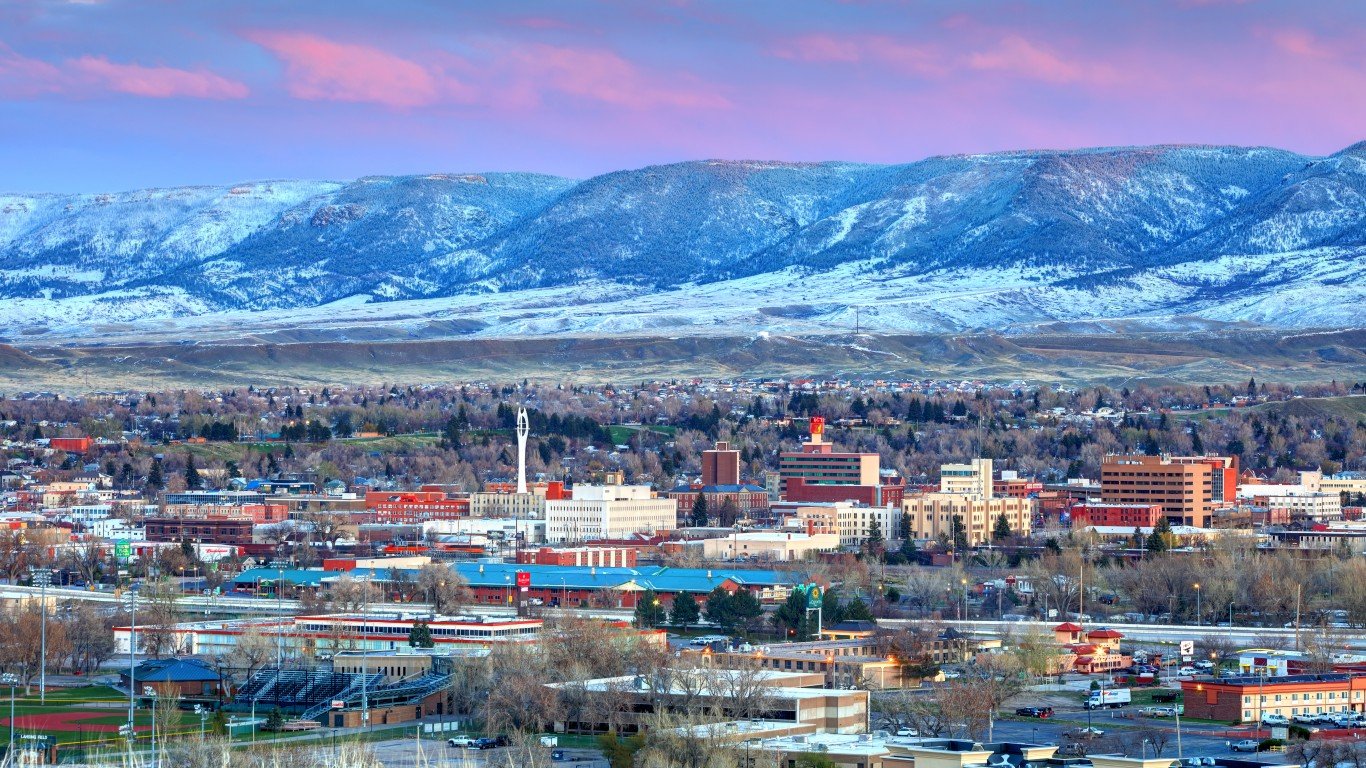
15. Wyoming
> Population: 578,803 (+0.3% in last year)
> Life expectancy at birth: 78.1 years (20th lowest)
> Median household income: $65,204 (20th lowest)
> Median home value: $266,400 (24th highest)
> Median housing costs as pct. of income: 16.8% (25th lowest)
> August 2022 unemployment: 3.1% (18th lowest)
The typical household in Wyoming earns $65,204 a year, about $4,500 less than the typical household nationwide. Still, serious financial hardship is less common than average, as the state’s poverty rate of 11.4% is well below the 12.8% national rate. Wyoming also has a strong job market, with an August 2022 unemployment rate of just 3.1%, below the 3.8% national jobless rate.
Crime is also less common in Wyoming than it is in most other states. There were 234 violent crimes and 1,611 property crimes for every 100,000 people in Wyoming in 2020, well below the respective national rates of 399 and 1,958 per 100,000 people.
[in-text-ad]

14. Connecticut
> Population: 3,605,597 (+0.0% in last year)
> Life expectancy at birth: 80.1 years (7th highest)
> Median household income: $83,771 (8th highest)
> Median home value: $311,500 (18th highest)
> Median housing costs as pct. of income: 19.4% (5th highest)
> August 2022 unemployment: 4.3% (8th highest)
Connecticut is one of the safest states in the country. There were only 182 violent crimes for every 100,000 people in the state in 2020, less than half the national violent crime rate and the fourth lowest of any state.
Incomes are also higher than average in Connecticut, as the typical household earns $83,771 a year, $14,000 more than the national median. The state also has one of the best funded school systems in the country. Average per pupil spending at the state’s public schools totals $20,271 annually, the second highest of any state.

13. Maryland
> Population: 6,165,129 (-0.2% in last year)
> Life expectancy at birth: 78.6 years (25th highest)
> Median household income: $90,203 (the highest)
> Median home value: $370,800 (10th highest)
> Median housing costs as pct. of income: 17.9% (15th highest)
> August 2022 unemployment: 4.4% (6th highest)
Maryland ranks among the 15 best states to live in nationwide and as the best state in the South largely because it is the wealthiest state in the country. With a median household income of $90,203, it is the only state where most households earn over $90,000 a year. High-paying jobs are likely a draw for college-educated workers. According to the census, 1.8% of all adults in the state who have a bachelor’s degree moved there in 2021 – one of the larger shares among states.
Maryland’s school system is also one of the best funded in the country, making the state a more attractive place for families to live. Average per pupil spending at the state’s public schools totals $15,149 annually, one of the highest of any state.
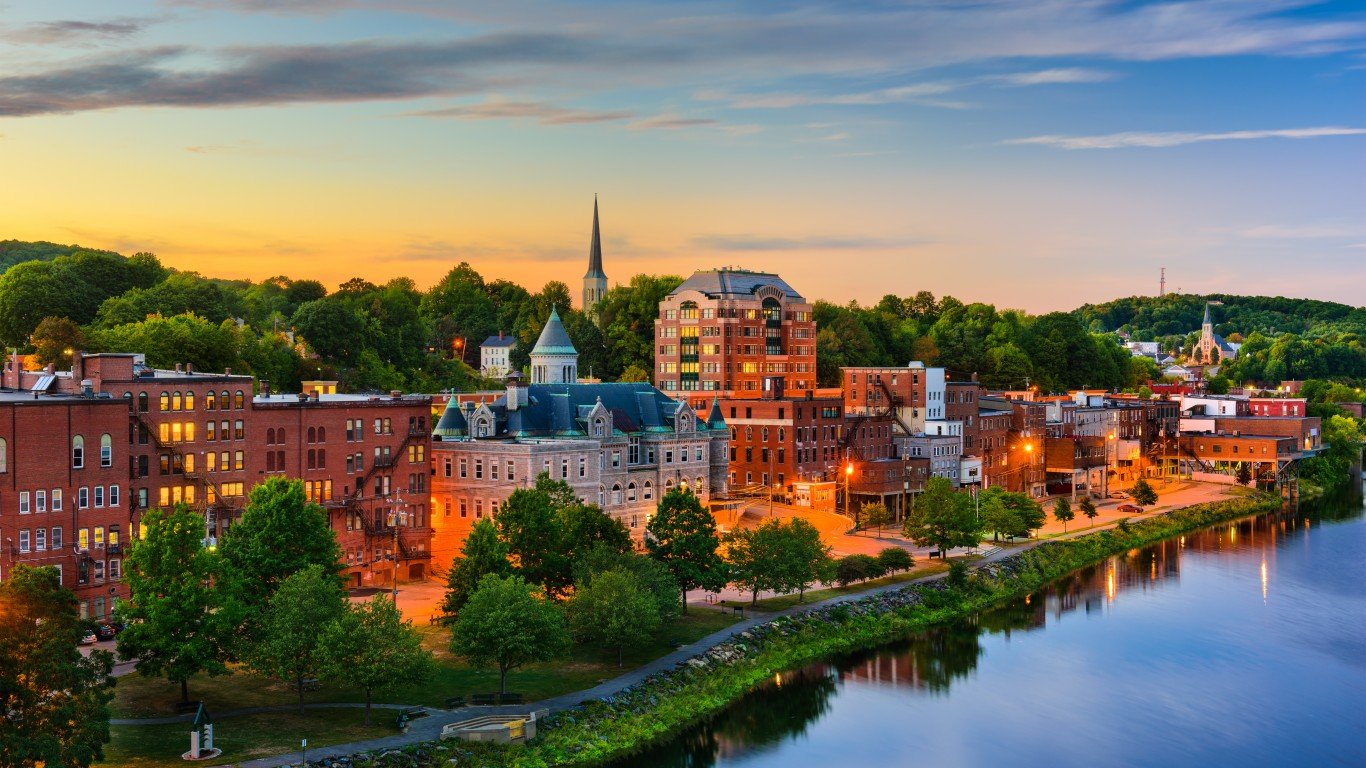
12. Maine
> Population: 1,372,247 (+0.7% in last year)
> Life expectancy at birth: 78.6 years (25th lowest)
> Median household income: $64,767 (19th lowest)
> Median home value: $252,100 (25th highest)
> Median housing costs as pct. of income: 17.2% (19th highest)
> August 2022 unemployment: 2.9% (13th lowest)
Maine ranks as the 12th best state to live in, largely because it is the safest state in the country. Its violent crime rate of 109 incidents per 100,000 people is the lowest of the 50 states and a fraction of the national violent crime rate of 399 per 100,000. While incomes in Maine are slightly lower than average, serious financial hardship is less common. The poverty rate of 11.5% is lower than in most states and lower than the 12.8% national poverty rate.
Maine also has a relatively strong job market, with just a 2.9% unemployment rate in August 2022, nearly a full percentage point below the 3.8% national rate.
[in-text-ad-2]
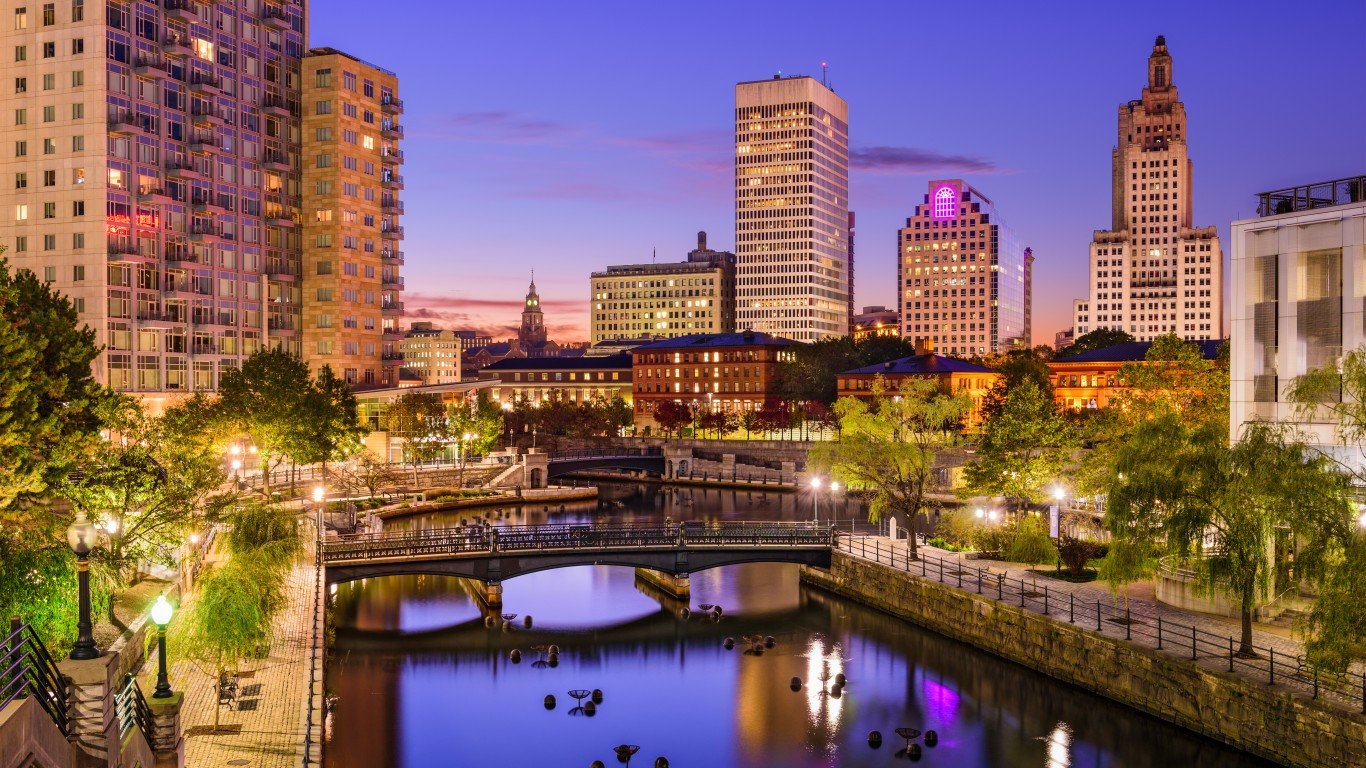
11. Rhode Island
> Population: 1,095,610 (-0.2% in last year)
> Life expectancy at birth: 79.4 years (15th highest)
> Median household income: $74,008 (15th highest)
> Median home value: $348,100 (13th highest)
> Median housing costs as pct. of income: 19.8% (4th highest)
> August 2022 unemployment: 3.9% (17th highest)
The typical household in Rhode Island earns $74,008 a year, about $4,300 more than the income of the typical American household. Additionally, the state’s poverty rate of 11.4% is well below the 12.8% national average. It is also a safer state than most, with a violent crime rate of 231 incidents per 100,000 people – the seventh lowest of any state.
Home values can be indicative of an area’s desirability, and in Rhode Island, the typical home is worth $348,100, about $66,700 more than the typical home nationwide.
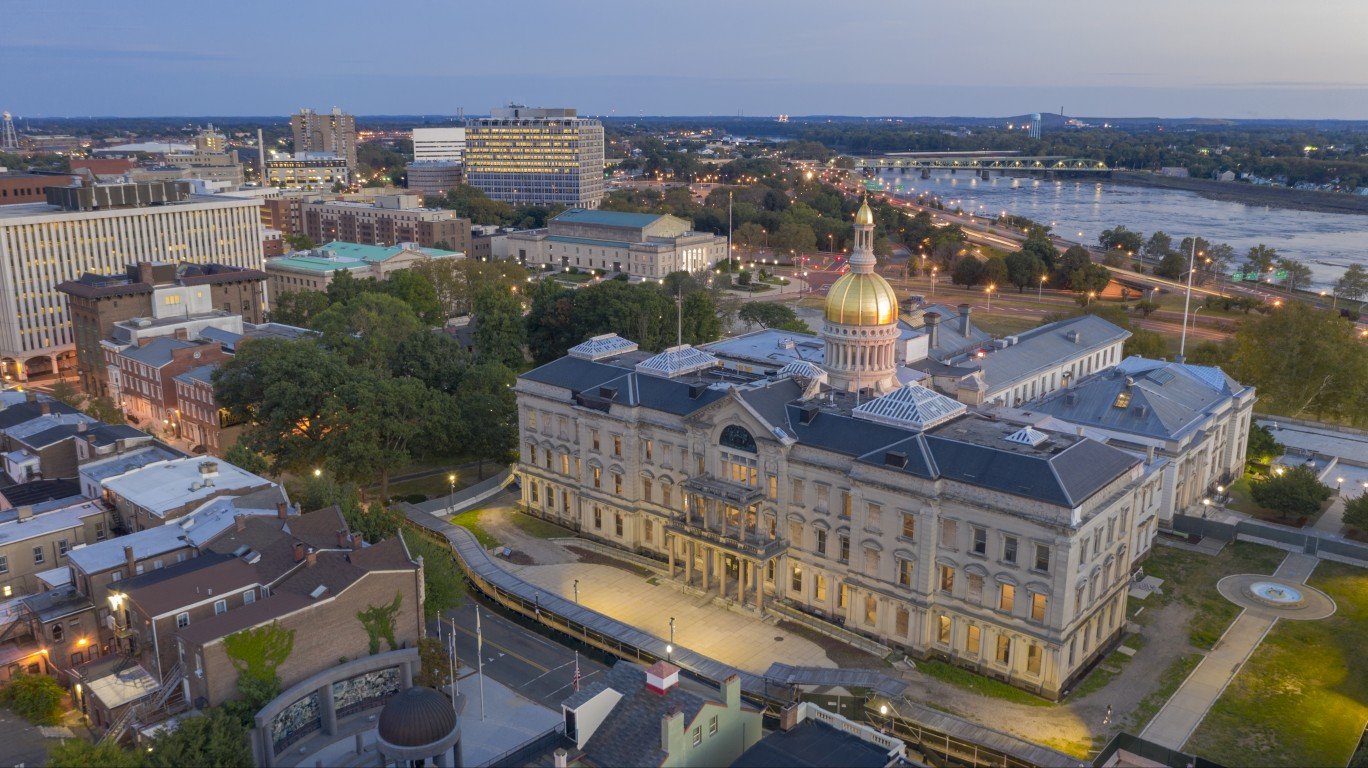
10. New Jersey
> Population: 9,267,130 (-0.2% in last year)
> Life expectancy at birth: 79.5 years (14th highest)
> Median household income: $89,296 (3rd highest)
> Median home value: $389,800 (8th highest)
> Median housing costs as pct. of income: 20.8% (2nd highest)
> August 2022 unemployment: 3.7% (21st highest)
New Jersey ranks as the 10th best state for overall quality of life in the country. The typical household in the state earns $89,296 a year, nearly $20,000 more than the typical American household. Additionally, only 10.2% of the state’s population live below the poverty line, compared to 12.8% of all Americans.
New Jersey is also a relatively safe state, with low rates of criminal violence. There were 195 violent crimes reported in New Jersey for every 100,000 people in 2020, the fifth lowest among states and well below the national violent crime rate of 399 per 100,000.
[in-text-ad]
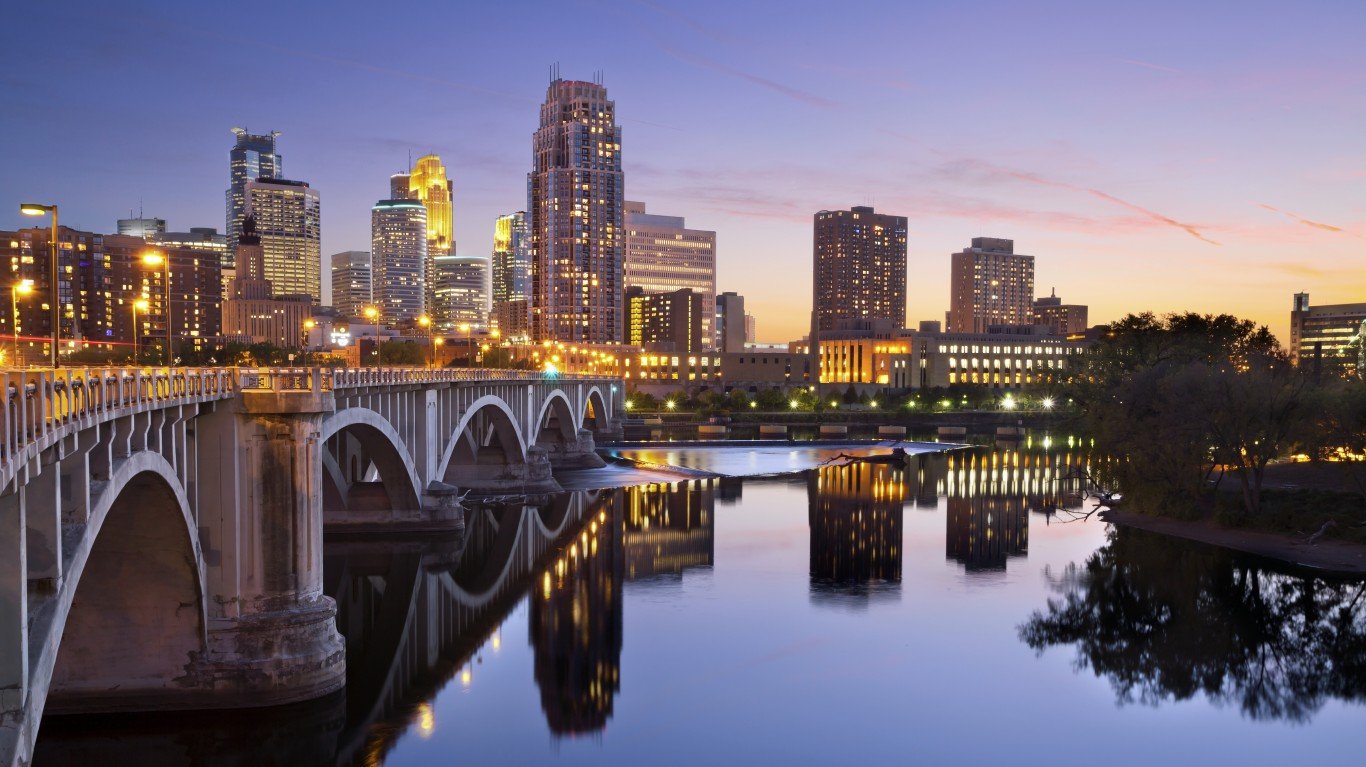
9. Minnesota
> Population: 5,707,390 (+0.0% in last year)
> Life expectancy at birth: 80.4 years (3rd highest)
> Median household income: $77,720 (13th highest)
> Median home value: $285,400 (22nd highest)
> Median housing costs as pct. of income: 16.8% (25th lowest)
> August 2022 unemployment: 2.1% (3rd lowest)
Minnesota ranks as the ninth best state to live in in the country and the best state in the Midwest. Not only does the typical state household earn about $8,000 more per year than the typical American household, but state residents also benefit from a lower than average cost of living. Housing in Minnesota is particularly affordable. Median housing costs – considering both renters and homeowners – account for only 16.8% of the income the typical household earns, below the 17.4% national ratio.
Other economic advantages in Minnesota include a low unemployment rate, which, at 2.1% in August 2022 was the third lowest among states. With a high median income and healthy labor market, only 9.3% of state residents live below the poverty line, well below the 12.8% national poverty rate.

8. Colorado
> Population: 5,812,069 (+0.7% in last year)
> Life expectancy at birth: 80.0 years (8th highest)
> Median household income: $82,254 (9th highest)
> Median home value: $466,200 (5th highest)
> Median housing costs as pct. of income: 18.6% (12th highest)
> August 2022 unemployment: 3.3% (22nd lowest)
Colorado ranks among the 10 best states for overall quality of life – largely due to economic conditions in the state. Most households earn over $82,000 a year, and the state’s poverty rate of 9.7% is the fourth lowest of any state in the country. As of August 2022, the unemployment rate stood at 3.3%, well below the national jobless rate of 3.8%.
Colorado’s strong job market and presence of high-paying jobs are likely attractive to many college-educated workers. According to the census, 2.5% of all adults in Colorado who have a bachelor’s degree moved there in 2021 – the third largest share among states.
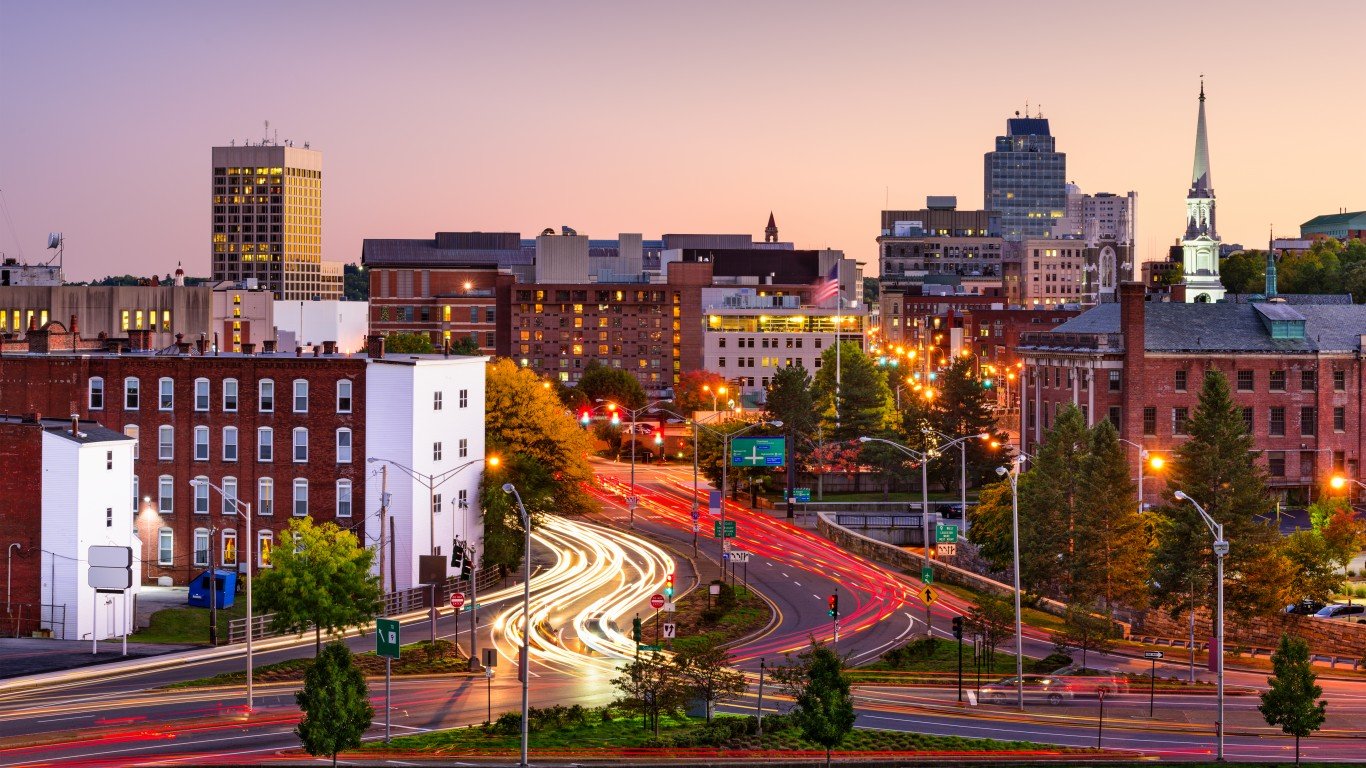
7. Massachusetts
> Population: 6,984,723 (-0.6% in last year)
> Life expectancy at birth: 80.2 years (6th highest)
> Median household income: $89,645 (2nd highest)
> Median home value: $480,600 (4th highest)
> Median housing costs as pct. of income: 19.4% (5th highest)
> August 2022 unemployment: 3.5% (24th highest)
Massachusetts is one of the wealthiest states in the country. The typical household in the state earns $89,645 a year, the second most of any state and about $20,000 more than the national median household income.
Like most states in the Northeast, Massachusetts invests far more than average in its public school system. Per pupil spending in the state totals $17,787 a year, the fifth most among the 50 states. Investment in public works and institutions does not stop with schools, as nearly 90% of the state’s population live in an area with easy access to places for physical exercise, such as parks and recreation centers, compared to just under 80% of all Americans nationwide.
[in-text-ad-2]

6. Virginia
> Population: 8,642,274 (+0.1% in last year)
> Life expectancy at birth: 79.1 years (17th highest)
> Median household income: $80,963 (10th highest)
> Median home value: $330,600 (16th highest)
> Median housing costs as pct. of income: 17.2% (19th highest)
> August 2022 unemployment: 3.2% (20th lowest)
Virginia ranks as the best state to live in in the South and the sixth best state to live nationwide. The state’s high overall quality of life is due in part to some strong economic indicators. For one, the state’s median household income of $80,963 is over $10,000 higher than the national median, and its poverty rate of 10.3% is among the 10 lowest of any state. Additionally, as of August 2022, Virginia’s unemployment rate stood at 3.2%, well below the 3.8% national jobless rate.
High incomes and a strong job market are likely attracting college-educated workers. According to the census, 1.8% of all adults in Virginia who have a bachelor’s degree moved there in 2021 – the eighth largest such share among states.
5. Utah
> Population: 3,337,975 (+2.0% in last year)
> Life expectancy at birth: 79.7 years (9th highest)
> Median household income: $79,449 (11th highest)
> Median home value: $421,700 (7th highest)
> Median housing costs as pct. of income: 17.1% (21st highest)
> August 2022 unemployment: 2.1% (3rd lowest)
Utah has one of the strongest job markets of any state. As of August 2022, its unemployment rate was just 2.1%, third lowest among states and well below the 3.8% national jobless rate. Incomes are also high in the state, with the typical household earning $79,449, about $10,000 more than the typical household across the U.S. as a whole.
Home values can be indicative of an area’s desirability, and in Utah, the typical home is worth $421,700, or $140,300 more than the national median home value. Even though homes are relatively expensive, housing in the state remains relatively affordable, relative to income. Median housing costs – considering both renters and homeowners – account for 17.1% of the income the typical household earns, compared to the 17.4% national ratio. Overall, goods and services are about 5% less expensive than average in Utah.
[in-text-ad]
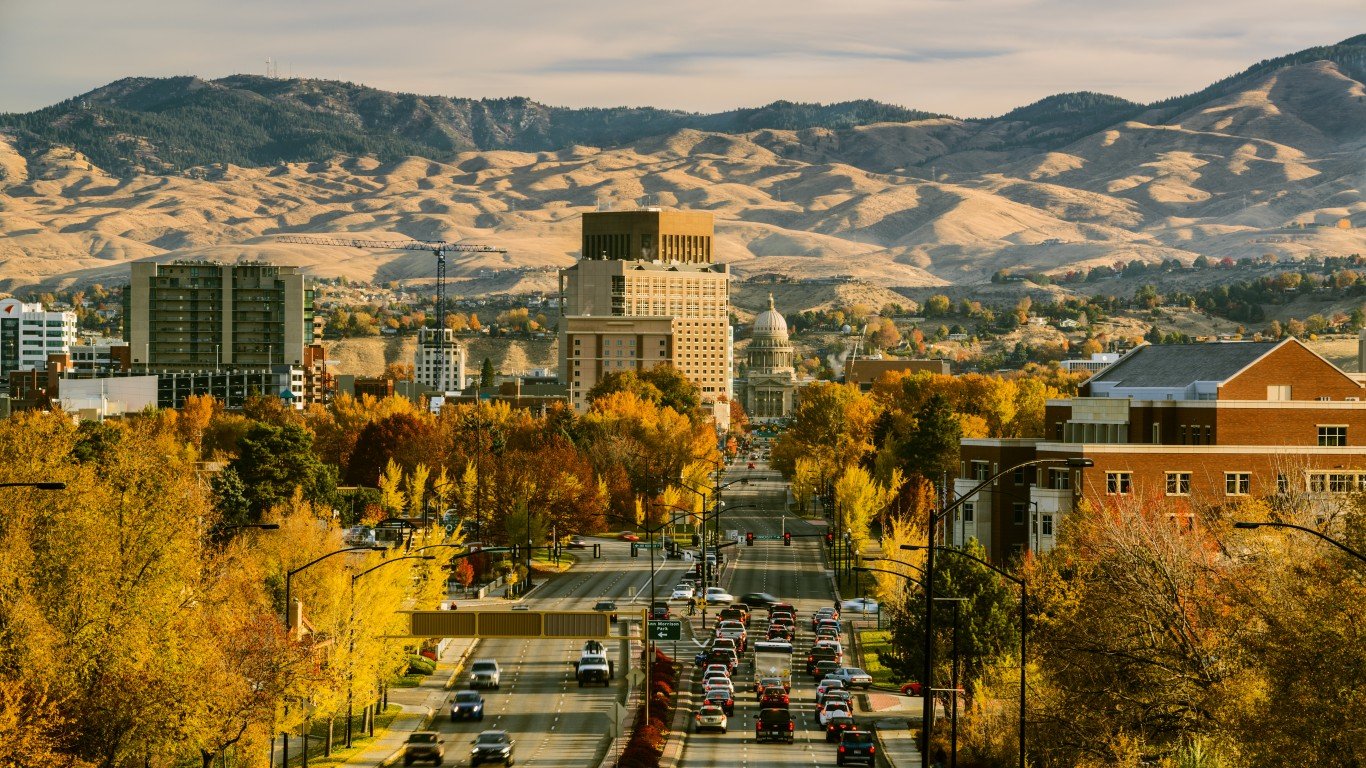
4. Idaho
> Population: 1,900,923 (+3.4% in last year)
> Life expectancy at birth: 79.2 years (16th highest)
> Median household income: $66,474 (24th lowest)
> Median home value: $369,300 (11th highest)
> Median housing costs as pct. of income: 16.8% (25th lowest)
> August 2022 unemployment: 2.7% (9th lowest)
Idaho ranks as the fourth best state to live in the country and the fourth best state in the continental Western United States. In 2021 alone, the state’s population grew by 3.4%, the largest increase in the country – and the growth was driven largely by people moving to the state. Home values can be indicative of an area’s desirability, and in Idaho, the typical home is worth $369,300, or $87,900 more than the national median home value.
Even though homes are relatively expensive, housing in the state remains relatively affordable, relative income. Median housing costs – considering both renters and homeowners – account for just 16.8% of the income the typical household earns, compared to the 17.4% national ratio. Overall, goods and services are about 9% less expensive than average in the state.
Idaho also has a strong job market. The August 2022 unemployment rate was just 2.7%, ninth lowest among states and well below the 3.8% national jobless rate.
3. Hawaii
> Population: 1,441,553 (-0.9% in last year)
> Life expectancy at birth: 82.3 years (the highest)
> Median household income: $84,857 (6th highest)
> Median home value: $722,500 (the highest)
> Median housing costs as pct. of income: 20.5% (3rd highest)
> August 2022 unemployment: 3.6% (23rd highest)
Based on several key social, environmental, and economic indicators, Hawaii ranks as the third best state to live in in the United States – and the only state outside of the Northeast to rank among the top three. The state has a warm climate and some of the cleanest air in the country, with low concentrations of harmful particulate matter.
Incomes in Hawaii are far higher than average. The typical household in the state earns $84,857, over $15,000 more than what the typical household nationwide earns. The state’s high quality of life is also due in part to low crime rates. Hawaii’s violent crime rate of 254 incidents per 100,000 people is the 10th lowest among states and well below the national rate of 399 per 100,000.
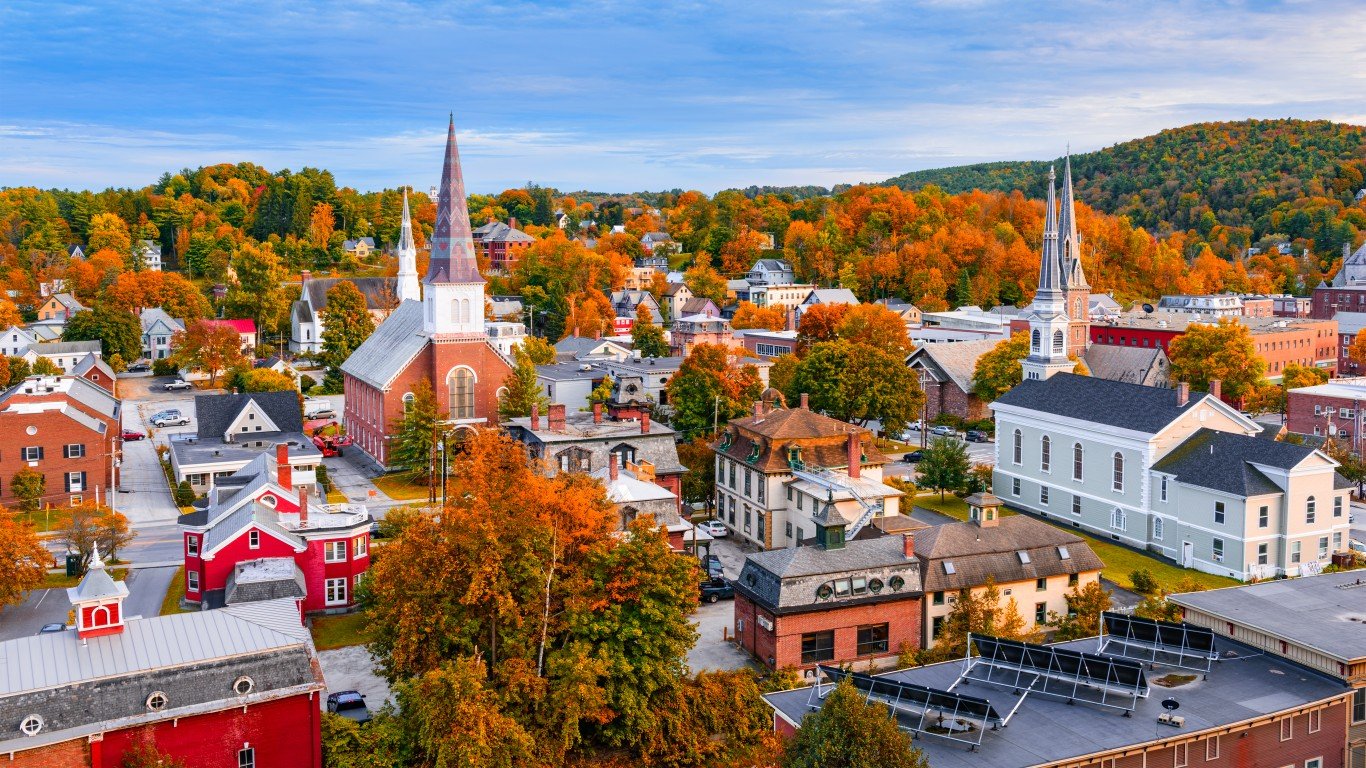
2. Vermont
> Population: 645,570 (+0.4% in last year)
> Life expectancy at birth: 79.7 years (12th highest)
> Median household income: $72,431 (16th highest)
> Median home value: $271,500 (23rd highest)
> Median housing costs as pct. of income: 18.9% (9th highest)
> August 2022 unemployment: 2.0% (the lowest)
Vermont invests more in its education system than most states. Per pupil spending across the state’s public schools totals $16,359 a year, eighth highest among states. Vermont also has the strongest job market in the country, with just a 2.0% unemployment rate in August 2022. For context, the national unemployment rate that month was 3.8%. Residents are also less likely than most Americans to face serious financial hardship. The state’s 10.3% poverty rate is 10th lowest among the 50 states and considerably lower than the 12.8% national rate.
Vermont’s high quality of life is also due in part to low crime rates. Its violent crime rate of 173 incidents per 100,000 people is the third lowest among states and well below the national rate of 399 per 100,000.
[in-text-ad-2]
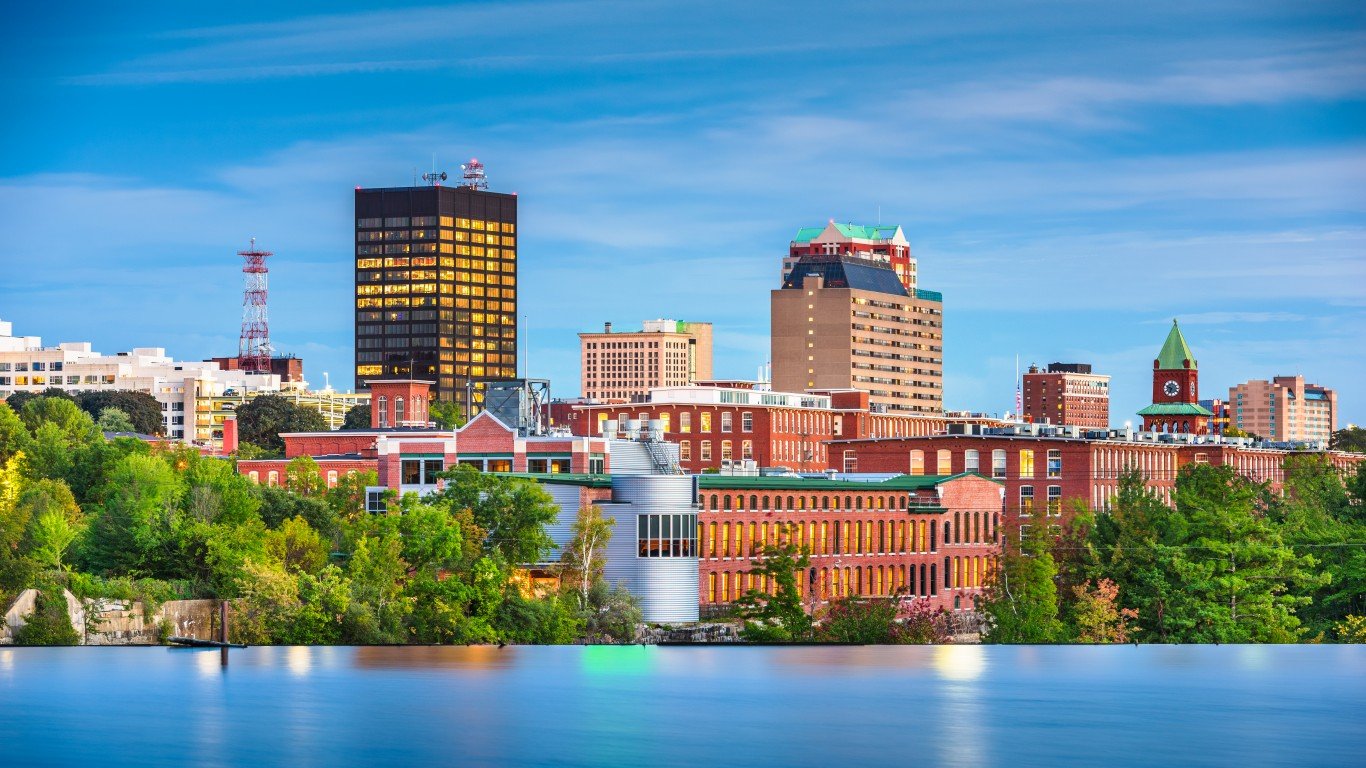
1. New Hampshire
> Population: 1,388,992 (+0.8% in last year)
> Life expectancy at birth: 79.6 years (13th highest)
> Median household income: $88,465 (4th highest)
> Median home value: $345,200 (14th highest)
> Median housing costs as pct. of income: 19.0% (8th highest)
> August 2022 unemployment: 2.3% (6th lowest)
Based on a number of key economic and social factors, New Hampshire ranks as the best place to live in the United States. The state’s job market is among the strongest in the country, with an August 2022 unemployment rate of just 2.3%, well below the 3.8% national rate. Incomes are also high, with most households earning over $88,400 a year. New Hampshire is also one of the safest states in the country, with a violent crime rate of just 146 incidents per 100,000 people, the second lowest among states.
New Hampshire is one of the fastest growing states in the country. Considering only net migration and excluding natural growth – births minus deaths – the state’s population expanded by 1.2% from 2020 to 2021, the ninth largest such increase of any state.
Methodology
To identify the best and worst states to live in, 24/7 Wall St. created an index of 16 measures related to, or indicative of, quality of life.
Five of the index measures are from the U.S. Census Bureau’s 2021 American Community Survey: 1. median household income; 2. the poverty rate; 3. the median home value; 4. the Gini index – a measure of income inequality; and 5. median annual housing costs as a percentage of household income, a measure of housing affordability.
We also considered two measures from County Health Rankings, a joint program of the Robert Wood Johnson Foundation and the University of Wisconsin Population Health Institute: 1. average life expectancy at birth based on calculations from 2018-2020; and 2. the share of the population who live in an area with easy access to places for physical activity such as parks or recreation centers calculated from 2010 and 2021 data.
Two components of the index are from the FBI’s 2020 Uniform Crime Report, the latest comprehensive UCR. These two measures are 1. the violent crime rate – which is a measure of the number of rapes, robberies, aggravated assaults, and homicides for every 100,000 people; and 2. the property crime rate, which is a measure of the number of burglaries, larceny thefts, and motor vehicle thefts for every 100,000 people.
We also considered four measures from four individual sources: 1. average daily sunlight over the period 1979 to 2011 from the Centers for Disease Control and Prevention’s North America Land Data Assimilation System; 2. public school per pupil expenditure for the 2018-2019 school year from the National Center for Education Statistics; 3. average daily concentration of particulate matter 2.5, or PM 2.5, a measure of air quality, in 2021 from the Environmental Protection Agency; and 4. the unemployment rate – not seasonally adjusted – for August 2022, the most recent monthly rate available, from the Bureau of Labor Statistics.
Finally, using data from the U.S. Census Bureau we calculated three measures: 1. percent population change due to net migration from 2020 to 2021; 2. adults with bachelor’s degree or higher who moved to the state in 2021 as a percentage of the 25 and older population; and 3. the homeownership rate, or the share of housing units occupied by their owner.
Sponsored: Find a Qualified Financial Advisor
Finding a qualified financial advisor doesn’t have to be hard. SmartAsset’s free tool matches you with up to 3 fiduciary financial advisors in your area in 5 minutes. Each advisor has been vetted by SmartAsset and is held to a fiduciary standard to act in your best interests. If you’re ready to be matched with local advisors that can help you achieve your financial goals, get started now.
Thank you for reading! Have some feedback for us?
Contact the 24/7 Wall St. editorial team.
 24/7 Wall St.
24/7 Wall St.
 24/7 Wall St.
24/7 Wall St.
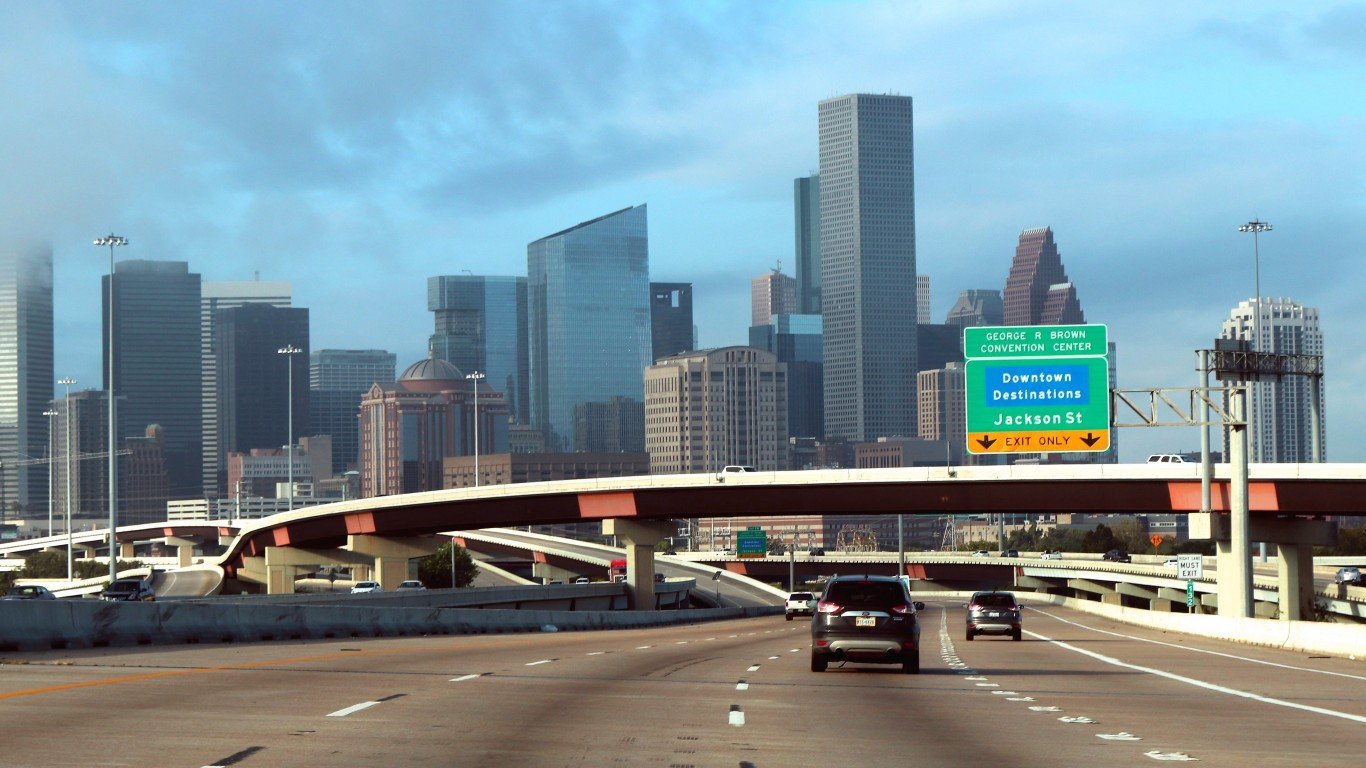


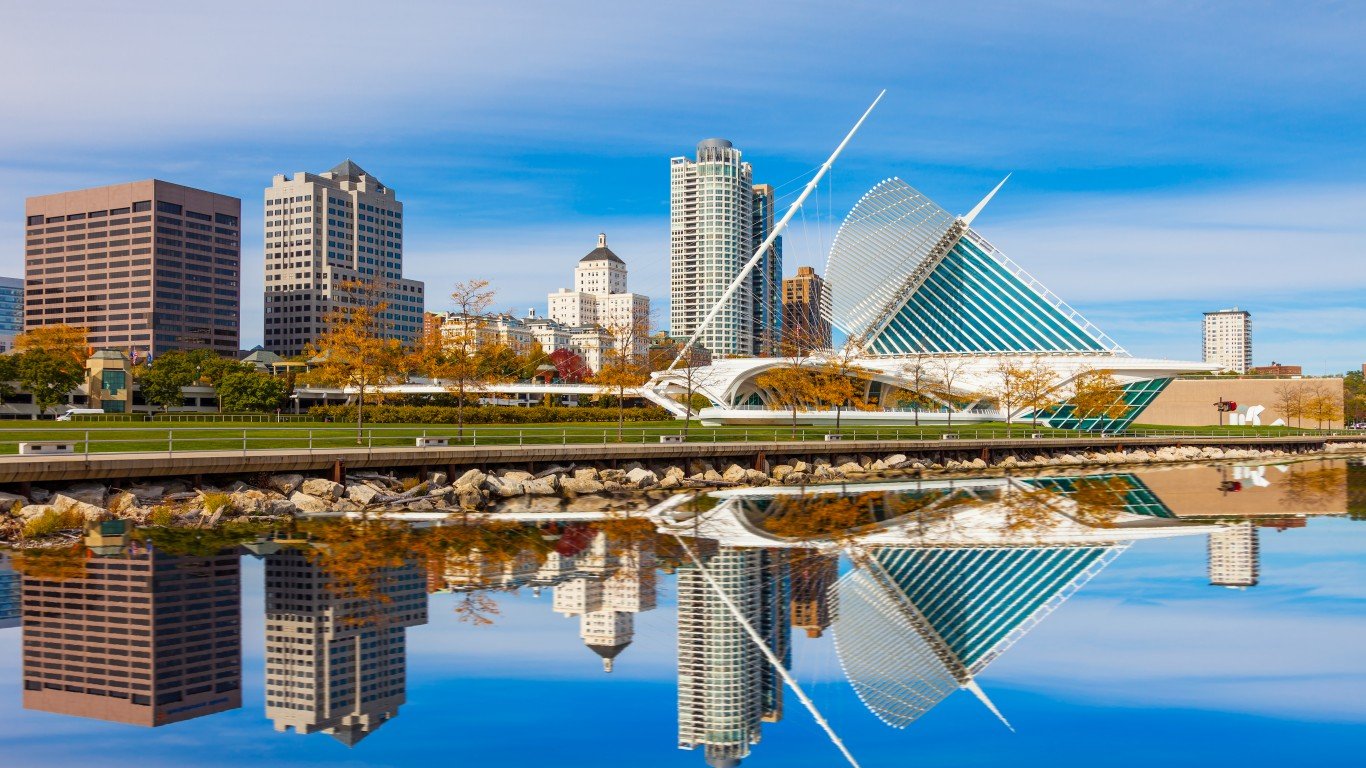 24/7 Wall St.
24/7 Wall St.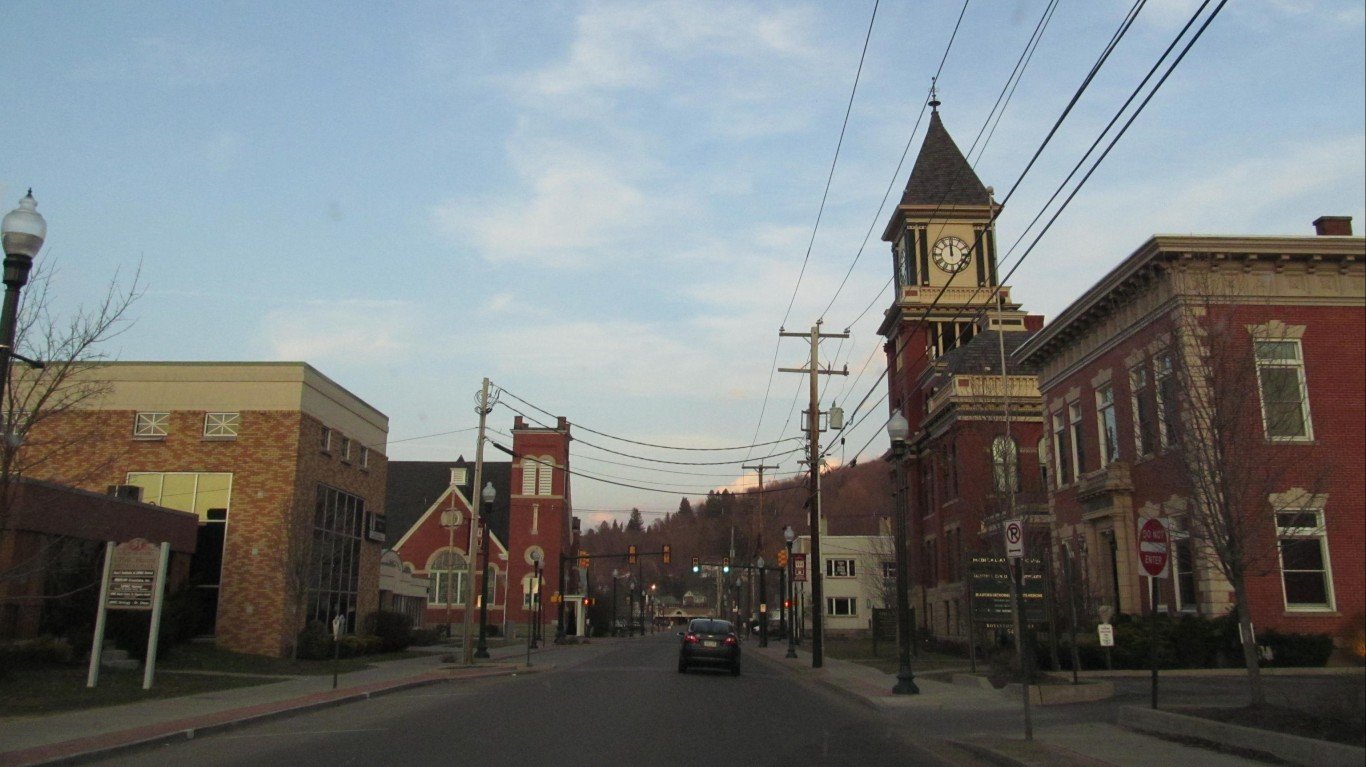

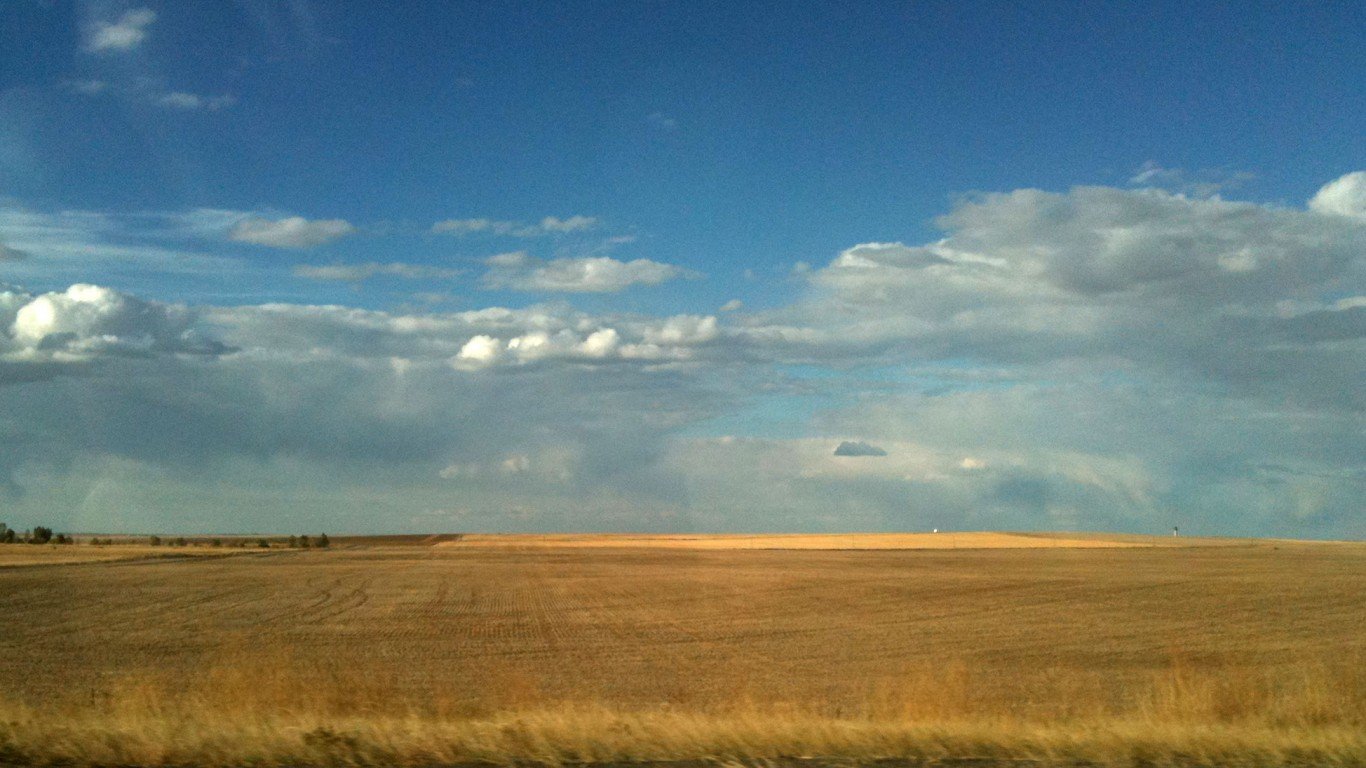

 24/7 Wall St.
24/7 Wall St.





